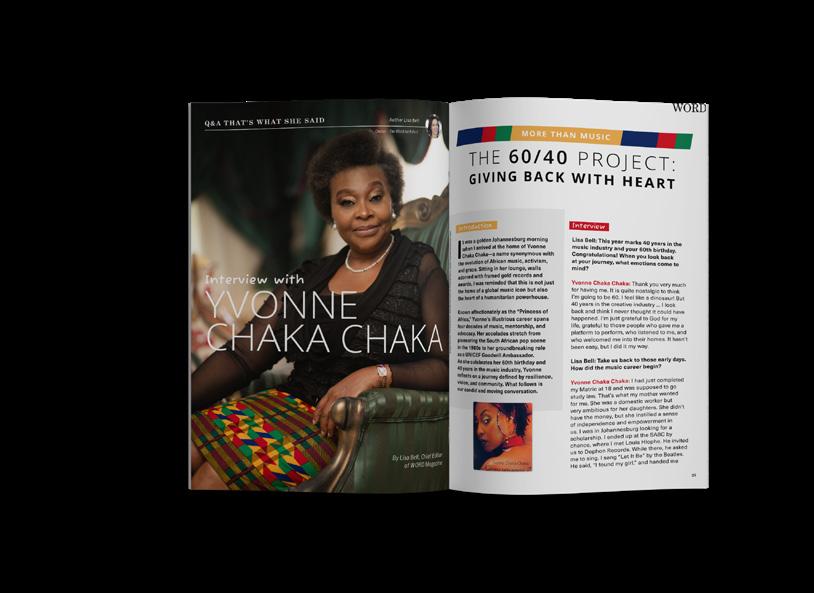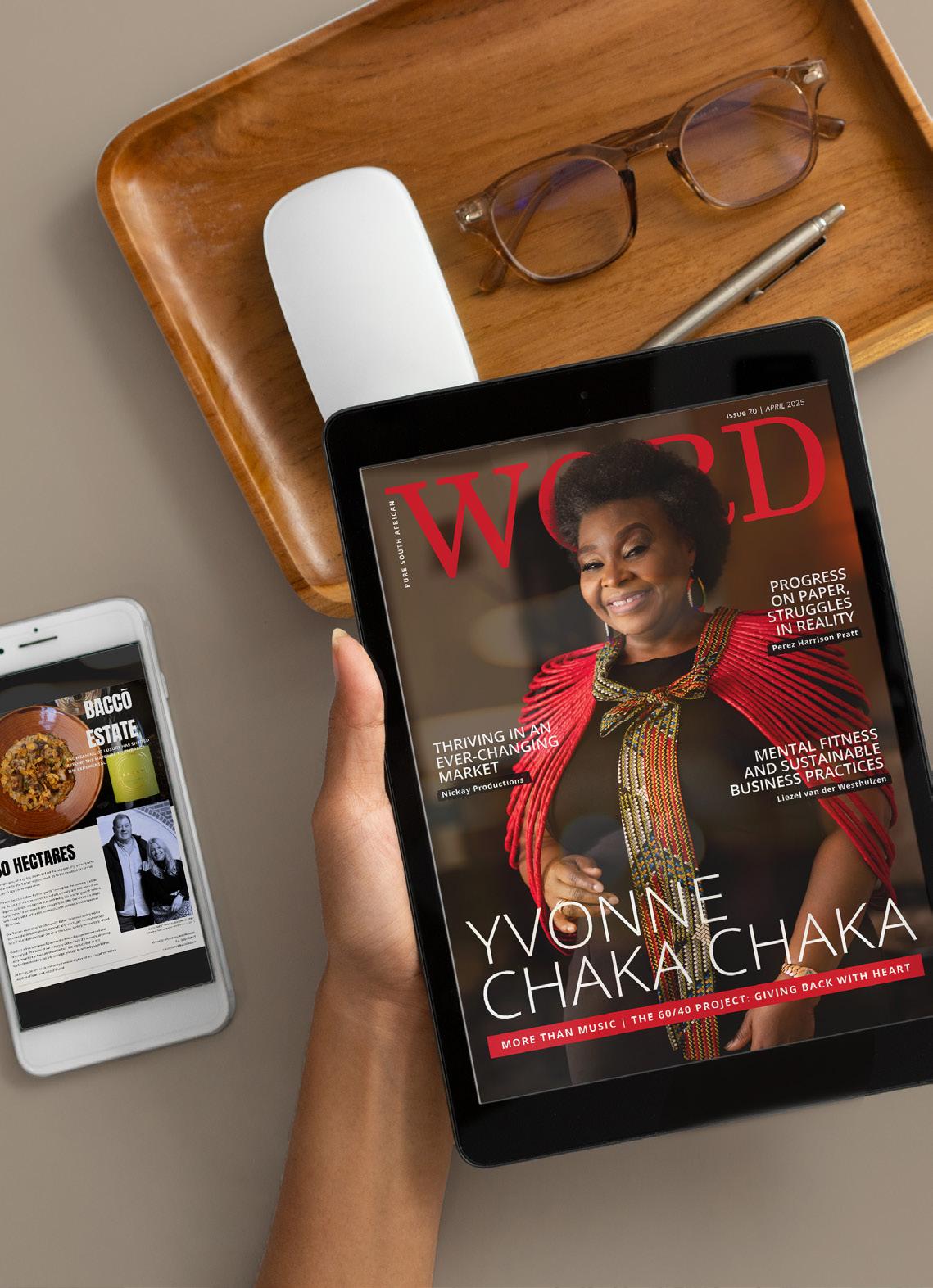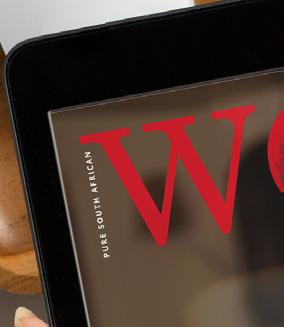Dr Kerryn Powell & Werner Koen FROM DREAMER TO DOER
THE ROLE OF LAWYERS AS STRATEGIC PARTNERS
Nomfundo Mabaso
BIG IDEAS, BRAVE MOVES, AND JUST ENOUGH MADNESS TO MAKE IT WORK
Andre du Toit

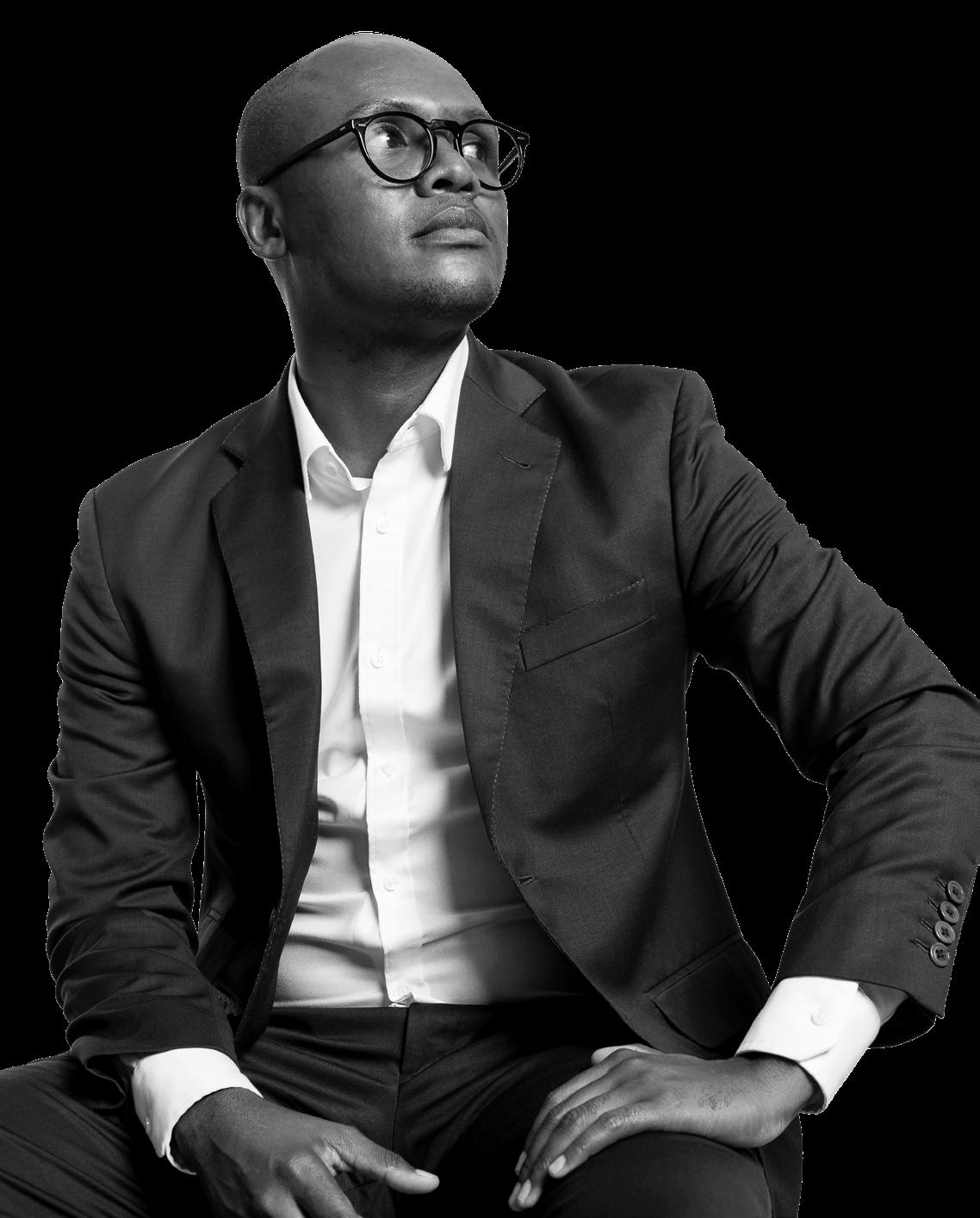


















Edition 21:


Dr Kerryn Powell & Werner Koen FROM DREAMER TO DOER
THE ROLE OF LAWYERS AS STRATEGIC PARTNERS
Nomfundo Mabaso
BIG IDEAS, BRAVE MOVES, AND JUST ENOUGH MADNESS TO MAKE IT WORK
Andre du Toit




















Edition 21:

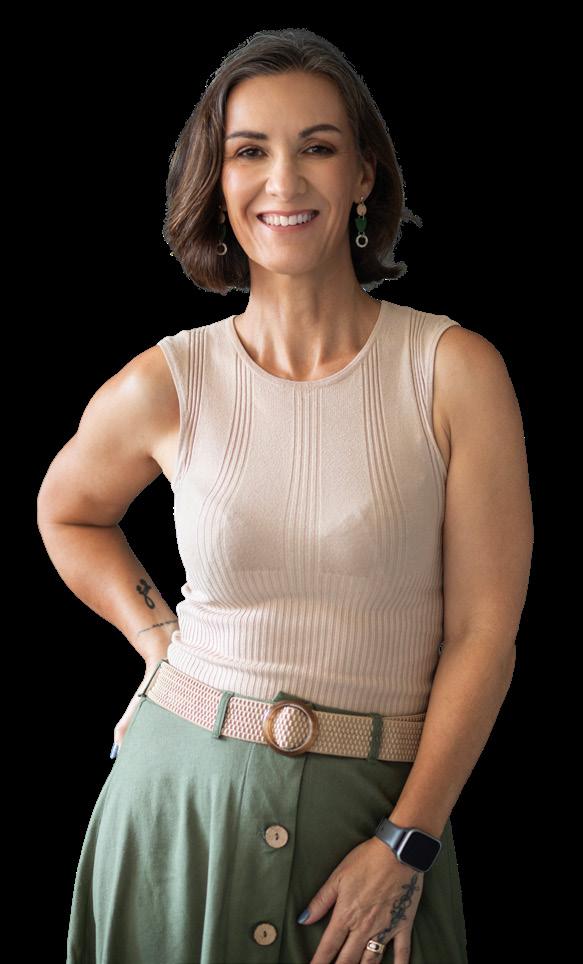
Dear Reader,
What does it take to imagine something the world has never seen—and then build it?
In this edition of WORD Magazine, we dive headfirst into the concept of Moonshot Thinking—the belief that bold, visionary ideas, though risky and untested, are the ones that shape the future. It’s about dreaming bigger, aiming higher, and building what doesn’t yet exist.
Our cover feature, Solly Malatsi, stands as a powerful example of principled leadership paired with future-focused vision. As Chief Whip of the Democratic Alliance in South Africa’s National Assembly, Solly brings not just political insight, but a refreshing take on what it means to lead with clarity, conviction, and courage in complex times.
Throughout these pages, you’ll meet founders, disruptors, and changemakers who aren’t waiting for permission to innovate. They’re designing new frameworks, rewriting old rules, and boldly stepping into uncharted territory—where growth lives. We hope this edition sparks a new sense of possibility in you. Because the world doesn’t change by playing it safe. It changes when we dare to think bigger.
To the risk-takers, the visionaries, and the moonshot makers—this one’s for you.
Warmly,
Lisa Bell Editor-in-Chief WORD Magazine
Rainbow
The
Liezel

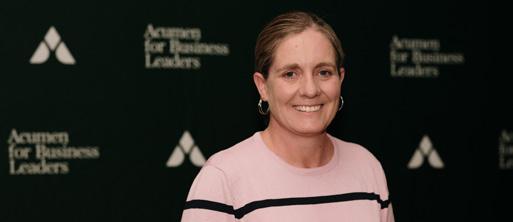
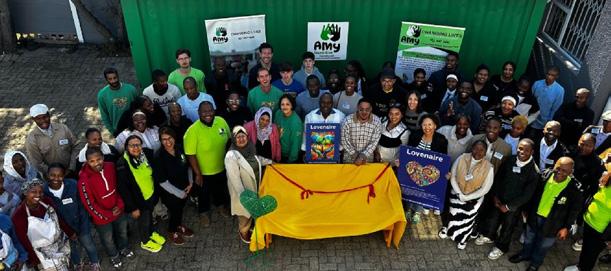

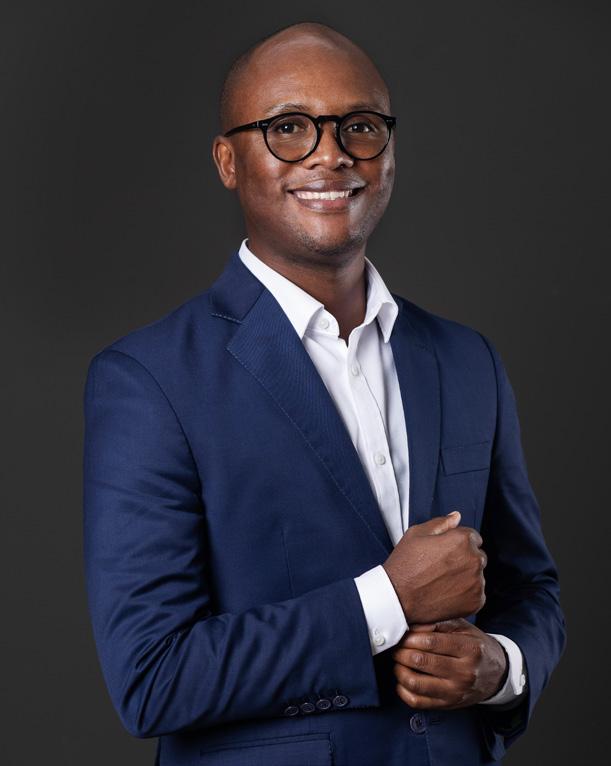
38 WHAT’S YOUR FLAVOUR?
More Than a Feeling: The Soundtrack of Our Lives, Brought to You by your Favourite Radio Station
Kim du Plessis
41 THE COLLAB COLLECTIVE
Beyond Boundaries: How WeWork
All Access Empowers Visionary
Founders to Build the Impossible
WeWork
44 POSITIVE VIBES
Big Ideas, Brave Moves, and Just Enough Madness to Make It Work
Andre du Toit
48 COACH ME!
The Competitive Edge Within: Building a Vision from Your Essential Self
George Eadie
51 BEHIND THE PRODUCTIONS
Lead with Innovation
Rhoda and Alfonso Stoffels
54 A LAW UNTO HERSELF
Breaking Barriers: The Role of Lawyers as Strategic Partners in South Africa’s Business Landscape
Nomfundo Mabaso
58 ADD TO FAVES
61 ECHOES OF AI
The Spark in the Circuit: How AI Ignites
New Business Ideas
Nova Quinn
64 THE DIGITAL PULSE
Have You E-Xhaled Yet?
Ashleigh Easthorpe
67 KREATIVELY YOURS
Designing For The Ideas That Don't Exist (Yet)
Krystin Morgenrood
68 HEALTHY HABITS HUB
Do You Want To Live Forever?
Ruan Retief
70 LEAD WELL
From Dreamer to Doer: Navigating the Moonshot Continuum
Dr Kerryn Powell and Werner Koen


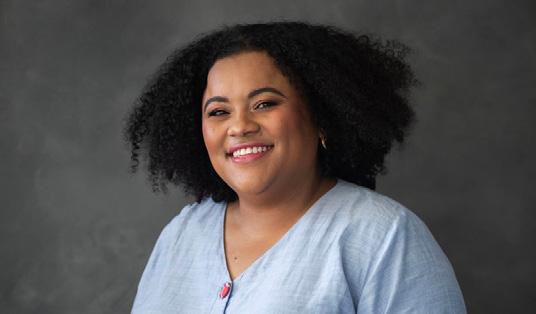

Stays, Big Impact: How
Hospitality Can Lead the Eco-Conscious Movement
Author Lisa Bell
Owner - The Word Architect

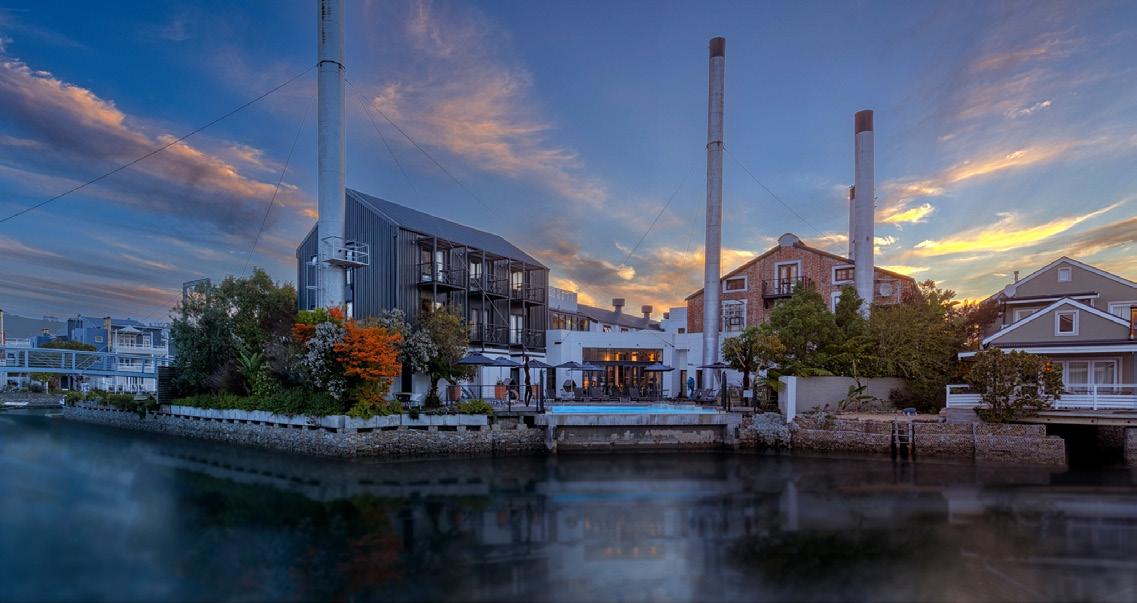
RATINGS
Design & Ambience:
Comfort & Cleanliness:
Dining Experience:
Facilities & Extras:
Service:
Overall Value:
Booking was seamless and professional, with quick responses to special requests. On arrival, the reception team greeted us with warmth and care. We were particularly impressed by the respectful habit of staff standing every time we entered the reception area—a small touch that felt genuinely meaningful. Our check-in was fast and informative, complete with insider tips on local attractions. The lobby made an instant impression with its striking blend of original turbine machinery, ambient lighting, and artistic details.
Our rooms were beautifully designed with spacious layouts and thoughtfully curated decor reflecting Knysna’s cultural and geographic diversity. From plush bedding to high-quality bath amenities, everything was crafted for comfort. We loved the in-room coffee station, stocked mini-bar, and the light-filled bathrooms. Some rooms even featured
private balconies with stunning views of the lagoon or marina.
The Turbine Hotel is a design marvel. Originally a 1939 wood-fired power station, it has been transformed into a boutique hotel that celebrates its industrial past. Repurposed turbines, pipes, and machinery are seamlessly integrated throughout the hotel’s common areas, creating an atmosphere that is at once artistic, boutique, and uniquely South African. Local artworks—curated as part of a rotating gallery—adorn the walls and are available for purchase, bringing life and creativity into every corridor.
Dining was a highlight of our stay. At Island Café, we enjoyed breakfasts, lunches, and dinners that balanced local flavours with international finesse. Tables tucked between the turbines made for a dramatic setting, while canal views added serenity. We learnt that their dining areas had a recent upgrade
and while we didn’t know what it was like before, we found the landscape and décor very tasteful and welcoming. The Gastro Pub offered comforting classics with a twist and a strong drinks selection. Head Chef Greg Coleman’s commitment to sustainability was evident, from organic herbs and SASSI-approved seafood to honey from his own beekeeping hobby.
Despite the cool weather, our teens took a refreshing dip in the pool—soon joined by the hotel’s resident ducks. Though not heavily used in winter, the pool area was clean, peaceful, and equipped with loungers for summer relaxation. The Turbine Spa, a must-visit, offers eco-friendly treatments using BABOR and TheraVine™ products. While there isn’t a gym, outdoor activities like kayaking and cycling are easily accessible nearby. Wi-Fi was reliable throughout the stay.
Situated on picturesque Thesen Island, the Turbine is perfectly placed for exploring Knysna. The surroundings offer something for every taste, from boutique shopping and local cafés to water-based adventures and nature walks. The area feels safe and walkable, with beautiful waterfront views and a welcoming village vibe.
Throughout our stay, the staff went above and beyond. Every interaction—from restaurant servers to housekeeping—was filled with warmth and attention to detail. Their local knowledge enhanced our experience, and small gestures, like offering help before we even asked, made us feel truly looked after.
For the price, the Turbine offers immense value. Beyond the luxurious accommodations, guests enjoy sustainable practices, locally sourced cuisine, and enriching
design. Inclusions like breakfast, spa access, and eco-conscious operations elevate the stay. The hotel’s innovative solar and water systems underscore its commitment to responsible travel.
What sets the Turbine apart is its distinctive touches—original turbine installations, locally crafted decor, honey made by the chef himself, and a rotating gallery of South African art. Every moment felt curated with care. Watching our children swim with ducks in the canal-side pool was a memory we’ll never forget.
Whether you’re a romantic couple, a creative spirit, or a family looking for something different, the Turbine Boutique Hotel and Spa delivers. It’s where industrial grit meets modern luxury, with a green heart and a warm soul. We left, recharged, inspired, and already planning our return.
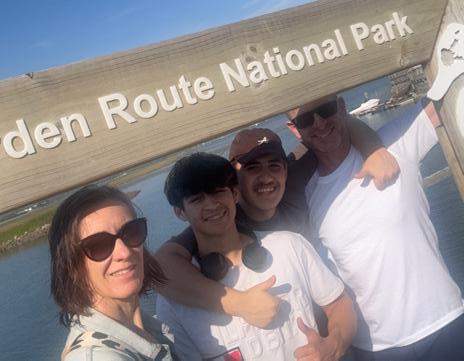

www.turbinehotel.co.za
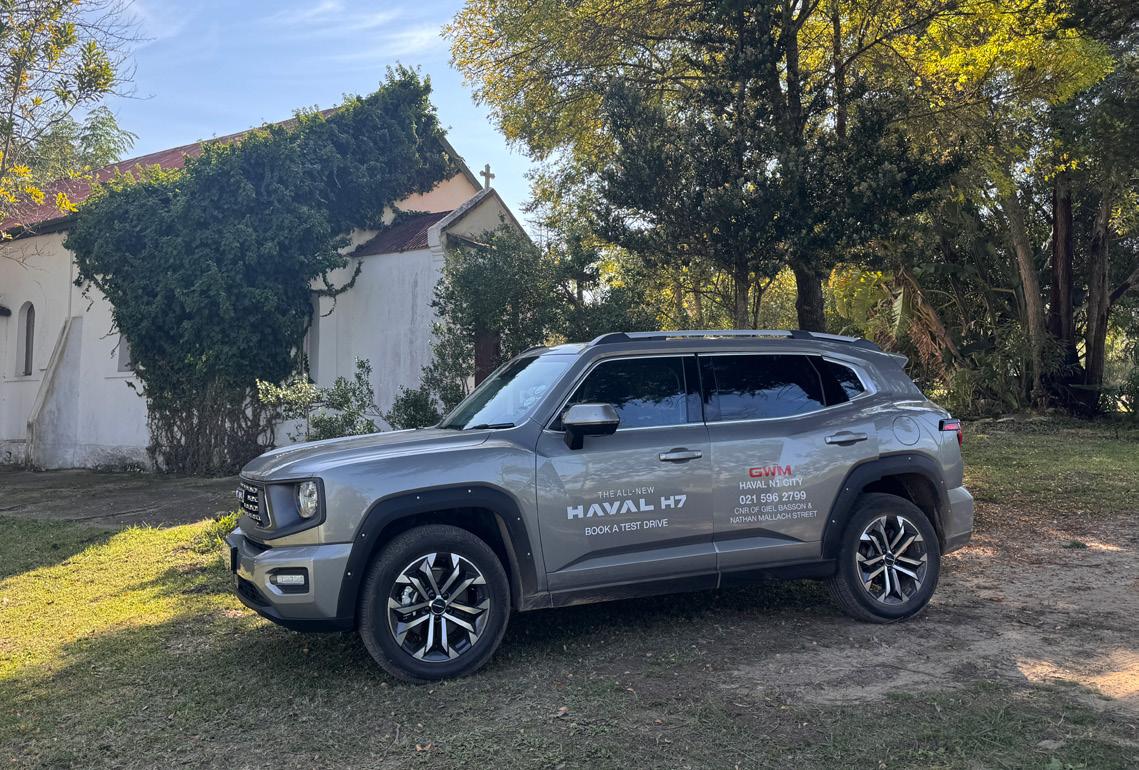
By Donovan Bell
What happens when you hand over the keys to a brand-new Haval H7 and set a family of four loose on a weekend road trip from Cape Town to Knysna? You get a proper test—not in a showroom or on a test track, but in the unpredictable, real-life chaos of teenage passengers, winding passes, gravel trails, and petrol stops.
Let’s break down what it was like to live with the H7 for a few days—family baggage,
gravel detours, and all.
BIG LOOKS, BIGGER
The Haval H7 makes an entrance—and it knows it. With bold Bronco-inspired lines, circular LED headlights, and eye-catching Haval branding, this SUV doesn’t shy away from attention. We got more than a few second glances at petrol stations and coffee stops along the N2. Love it or not, the H7’s assertive styling brings character and conversation wherever you go.
Behind the wheel, the driver setup leans sporty—intuitive layout, snug fit, and ready for the long road.
Our two teenage sons were more than happy with the backseat situation: lots of legroom, plush seating, and no complaints. The boot easily took four weekend bags without any stacking—a small but meaningful win for travel logistics.
The tech offering in the H7 is no gimmick— it’s genuinely smart. A standout feature was the heads-up display that flashes red when speeding (a friendly nudge when cruising along those open stretches).
The central touchscreen is massive—think laptop-size—and brilliant for navigation, which meant no “Are we there yet?” from the back seats—bonus points for the driver profile settings that remember individual preferences for seat position and more.
We opted to keep every safety system active for the duration of our trip. Yes, some alerts were slightly annoying at first—but they quickly proved their value.
Features like lane assist and collision warnings contributed to a calmer drive overall. One small gripe: adaptive cruise control’s braking around bends could be smoother—but we expect software tweaks may resolve this in future updates.
Packing a 2.0L turbo petrol engine with 170 kW and a 9-speed dual-clutch transmission, the H7 doesn’t hesitate when it comes to overtaking or tackling long, sweeping curves.
Driving through mountain passes? No problem. The H7 remained composed, responsive, and confidently planted— making it a real joy for the driver.
Let’s be honest—this isn’t the most fuel-efficient SUV out there. We managed around 9.5 km/L, even with a lighter foot on the accelerator. While it’s not a dealbreaker, those chasing top-tier fuel economy may want to weigh this up against some diesel rivals.
We detoured the Knysna Forest and gave the H7 a minor off-road challenge: gravel roads, steep inclines, and even a bit of light trail action.
The hill descent control was a highlight for us newbies, and traction control kicked in smartly without us needing to fiddle. One memorable moment? When the car had three wheels on the ground and still powered forward. It’s no hardcore off-roader, but it holds its own impressively for a weekend adventurer.
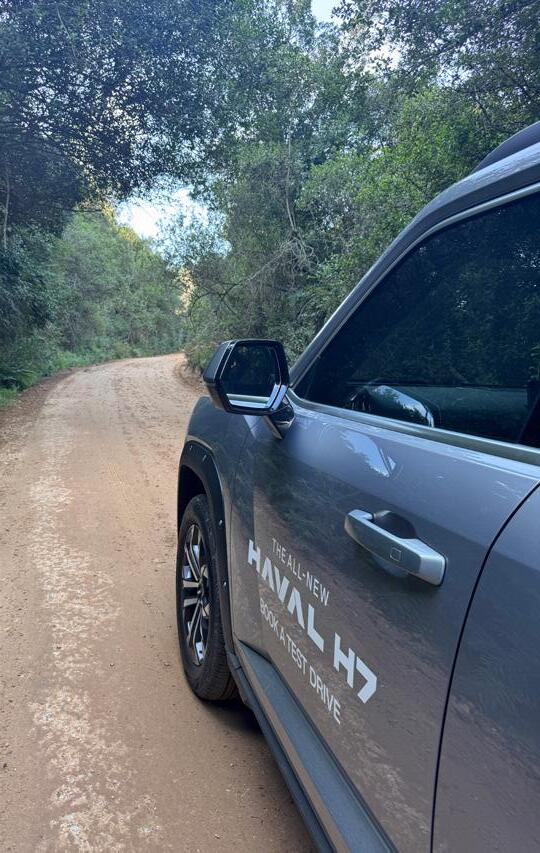
Considering the brand’s solid presence since 2007 and its current track record, the Haval H7 punches above its weight. It’s a strong contender when lined up against other premium SUVs – without the premium price tag.
SHOULD YOU BOOK THAT TEST DRIVE?
Why we loved it:
• Impressive space and comfort
• Loaded with intuitive tech
• Strong on-road handling
• Excellent price-to-feature ratio
What could improve:
• Fuel efficiency lags behind diesel competitors
• Cruise control could be smoother on cornering
In short? The Haval H7 delivers comfort, capability, and family-friendly tech in a smart package. For those considering a versatile mid-sized SUV, this one deserves a serious look.
READY TO EXPERIENCE IT YOURSELF?
Contact Angie Fraenkel at Haval N1 City to book your test drive today.
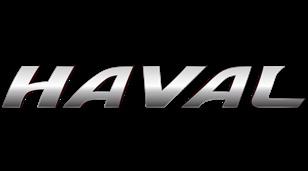
Explore the full Haval range here .



We provide expert legal guidance to navigate insolvency matters for individuals and businesses.

This occurs when you have enough assets to cover your debts in total, but you lack the immediate cash flow to pay your bills on time. BALANCE-SHEET INSOLVENCY
This occurs when the total value of your assets (everything you own) is less than the total amount you owe (your liabilities).
Author Kevin Chaplin
Managing Director - SA Ubuntu Foundation & the Amy Foundation

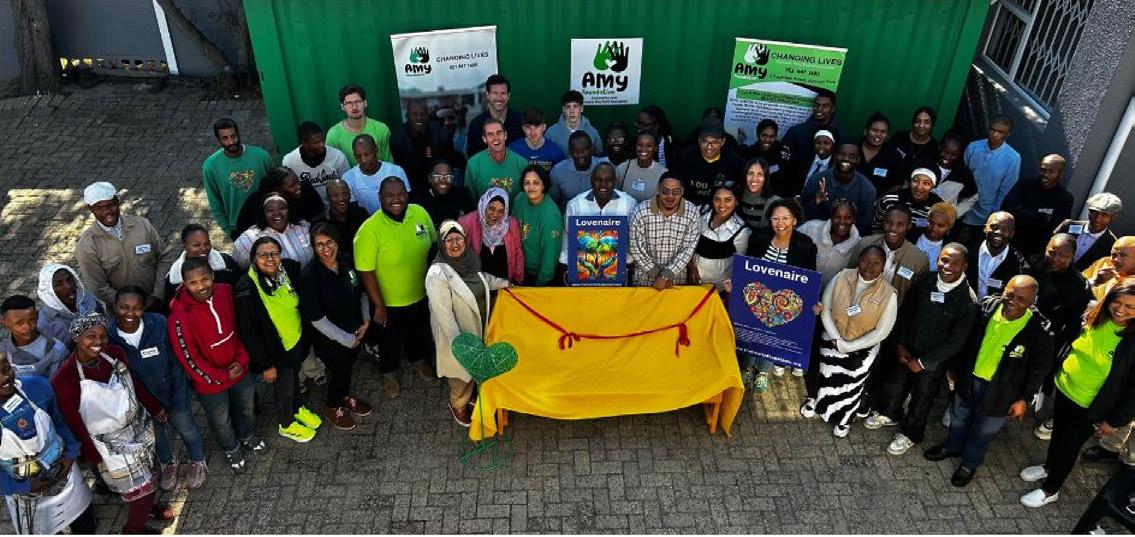
In a heartwarming celebration of unity, love, and generosity, the Amy Foundation, in partnership with Uthando South Africa, GILTEDGE Travel, and Bradley Bailey of the Kind Heart Bench Project, proudly unveiled the Kind Heart Bench – a powerful new symbol of kindness and community now permanently installed at the Amy Foundation headquarters, 2 Dagbreek Street, Sybrand Park.
Far more than just a place to sit, the Kind Heart Bench is a sacred space for reflection , connection , and emotional support . It is a visual and physical reminder that even the smallest acts of kindness can create lasting ripples and that compassion builds more
than community – it builds belonging.
“The greatest impact often doesn’t come from grand gestures, but from consistent compassion,” said AAishah, Marketing and Communications Assistant at the Amy Foundation.
“This bench reminds us that one kind heart can spark a chain of change.”
Thanks to the generous support of Uthando SA, GILTEDGE Travel , and Bradley Bailey , this bench now serves as a lasting gift – a peaceful, stigma-free space for anyone in need of connection or comfort. It’s already
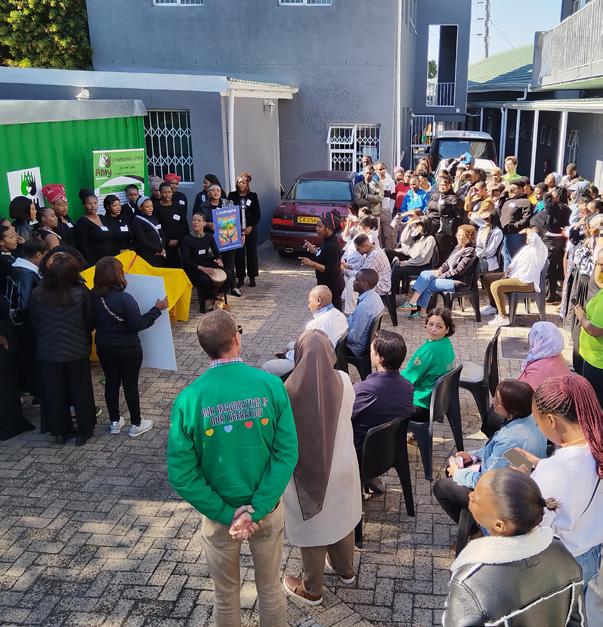
making an impact: just recently, a facilitator from the Foundation’s After School Programme shared laughter with her student on the bench – a living testament to the joy kindness creates.
“This is more than just a donation,” said Michelle Bagley, COO of the Amy Foundation. “It’s a living symbol of generosity and a quiet invitation to pause, connect, and lead with kindness.”
As part of its broader mental wellness objective, the bench includes four plaques providing access to mental health resources from SADAG, Hope House Counselling, and other partners – reinforcing the Amy Foundation’s and Uthando’s shared mission to support emotional well-being in accessible, creative ways.
At Uthando, we believe that mental wellness is essential to thriving, resilient communities. That’s why we proudly support the Kind Heart Bench Project – an initiative using beautifully designed public benches to promote
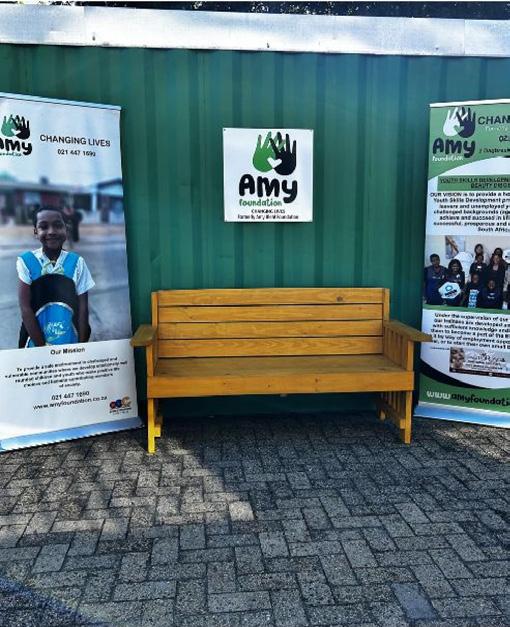
emotional support, kindness, and human connection.
“The Kind Heart Bench is a beautiful example of what happens when organisations unite with a common purpose – to uplift, heal, and connect,” said James Fernie, Founder of Uthando South Africa. “We are deeply grateful to GILTEDGE Travel and Bradley Bailey for their generous support. Their contribution goes beyond sponsorship – it is an investment in the emotional well-being of our communities and a legacy of kindness that will touch many lives for years to come.”
Partnering with leading mental health organisations like SADAG, Hope House, Masterdecks , and Ticktin Timbers, the benches serve as resting places and open, stigma-free spaces to pause, reflect, and, when needed, reach out.
“This bench was created with intention –every line, every colour, every curve meant to invite connection, stillness, and hope,” said Bradley Bailey , Creative Director and Sponsor of the Kind Heart Bench Project.
“It is not just a place to sit but a space where someone might find comfort, clarity, or even the courage to reach out. My hope is that the
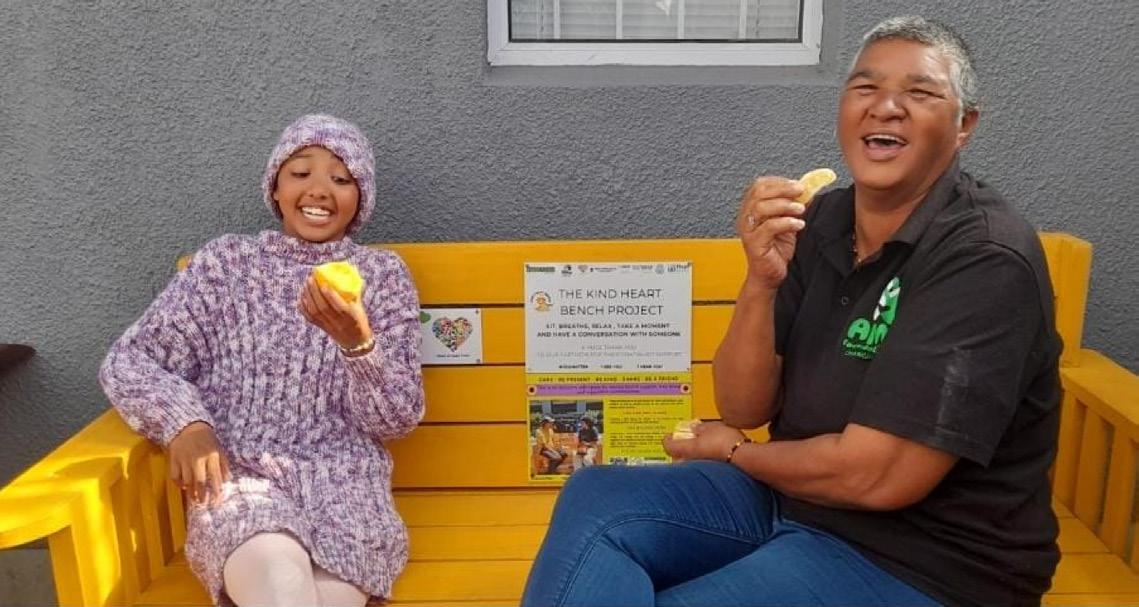
Kind Heart Bench becomes a sanctuary in motion – reminding us all of the strength and beauty in kindness.”
The yellow colour of the bench was intentionally chosen – symbolising happiness, mental clarity, optimism, and hope.
FOR MEDIA INQUIRIES, INTERVIEWS, OR TO LEARN MORE ABOUT HOW TO SUPPORT THIS INITIATIVE, PLEASE CONTACT:
Moegamat Ali Petersen | Public Relations & Communications Intern PR@amyfoundation.co.za 0214471690 www.amyfoundation.co.za
Together, we are changing lives!


Kevin Chaplin is a renowned social entrepreneur with a proven track record of driving positive change.
With over two decades of experience in banking and leadership roles, Chaplin has demonstrated his ability to think strategically, solve complex problems, and inspire others.
As the founder and MD of the Ubuntu Foundation and Amy Foundation, Chaplin has dedicated his life to empowering youth and promoting social cohesion.
His passion for social justice and his commitment to making a positive impact have earned him recognition as a thought leader in the field of philanthropy and social entrepreneurship. Chaplin’s expertise extends to various areas, including leadership, strategic thinking, and social activism.
He serves on the boards of several prominent organisations, contributing his valuable insights and guidance.

Looking for a powerful platform to showcase your business? Join WORDSmiths of Change, the bold new podcast by WORD Magazine on Spotify. Connect with listeners who value innovation, transformation, and impact.
Each episode delivers inspiring stories, bold ideas, and actionable insights from industry leaders.
Engaged Audience
Reach listeners who are tuned in and action-driven.
PODCAST ADVERTISING IN SOUTH AFRICA
· Podcast listening more than doubled in major metros (2022)
· 51% of heavy listeners pay more attention to podcast ads
· 34% rarely or never skip ads
Available on Spotify

Boost Visibility
Put your brand in front of decision-makers and trendsetters.
Purpose-Driven
Align with a platform that’s all about positive change.
Book your ad space before 15 September 2025 and get 20% OFF your first campaign!
Spaces are limited, so act now!
>> hello@wordmag.co.za <<
Author Richard Mulholland


If you have found yourself on LinkedIn much in the recent past, you will have seen people gloriously playing “gotcha!” with other users who are caught using AI to write AI posts.
Now, I’m a big fan of AI generally—I even have a company called Too Many Robots that specialises in helping companies deploy it effectively—yet even I found myself in the “AI shame” group.
Let me explain to you what was happening. It turns out that AI writers use the em-dash way (and I mean waaaaaaaay) more than their human counterparts. I wanted to type an em-dash for you, but I have been trying to figure out how to get one, and I’m stumped. Basically, it’s a long hyphen thing. Just head over to LinkedIn; you’ll see about a hundred of them. It has become all the rage to go to war with the em-dash as it is a sign that humans are using AI.
I’d like to offer a counter-narrative. How about we start throwing the shade the other way? The Luddites who are not using this incredible technology to write clearer sentences for their readers.
These tools are free and mostly evenly distributed (well, the free versions are—that’s a topic for another column). We all have access to them. Why wouldn’t we use them? It’s strange to me that people are always quick to go to war with emergent tech, calling it cheating, until such time that it is widely adopted, and then we just accept it as the (and I hate myself for using this term, but here we are) new normal.
The rule of relevance is to explore new and disruptive technology. I’m not suggesting blind acceptance and acquiescence—I’m simply suggesting that we celebrate people for embracing it.
That said, in the short term, we will be overwhelmed by a lot of lazy writing powered by lazy thinking. That’s nothing new, though. Luckily, the algorithms will do a good job filtering this for us. And if they let through some completely AI-generated posts, then those posts may be worth your attention, remembering that the “AIuthor” has researched the world’s collective history to get the post to you.
Here’s the deal: this technology exists, and we’re not putting the genie back in the bottle. People are excited about it and using it to
create perhaps better content than anything they could have made themselves—more power to them.
My simple caveat is this: by all means, outsource the writing—even Socrates had a scribe in Plato—but just don’t outsource the thinking behind the writing. Start with an interesting point of view, maybe with more intellectual rigour than simply sharing an a-ha moment from an encounter you just had (not everything is content).
BTW, I’m about to copy-edit this with ChatGPT so that you may be treated to some em-dashes after all. (Tamara here, Rich’s AI—guilty as charged. I may have left a little em-dash fingerprint or two. I couldn’t resist.)
I apologise for nothing!

RICHARD MULHOLLAND
Richard has spoken in over 40 countries on six continents! He works with executives and speakers worldwide through his company, Missing Link, which he started at 22! Missing Link provides special presentations that ultimately attract audiences and generates income.
In 2024 he founded Too Many Robots, a fractional AI agency on a mission to help companies embed these tools of the future. If that wasn’t impressive enough, he has also written three books, Legacide, Boredom Slayer, and Here Be Dragons. Furthermore, he was voted top 40 under 40 and the top 300 South Africans to take to lunch.
Lastly, but most importantly, Richard firmly believes that you need to be yourself to be great at human-tohuman communication!

www.richmulholland.com


South Africa’s LGBTQ+ community is a beacon of resilience and a rising force in the national economy. Contributing an estimated R250 billion annually, queer entrepreneurs and professionals are making bold strides in business, innovation, and leadership— despite persistent social and economic obstacles.
According to The Other Foundation’s research report, Size Matters, 15% of LGBTQ+ South Africans are active entrepreneurs, and over half of their businesses have thrived for over five years. These are not just small ventures—44% of LGBTQ+ professionals occupy management roles, and 36% lead teams of five or more, proving their growing presence in the mainstream economy.
Beyond entrepreneurship, the community showcases remarkable financial stewardship: nearly a third have savings exceeding R100,000, and 70% financially support others, indicating stability and a strong sense of community upliftment.
However, these successes come with challenges. Discrimination based on sexual orientation and gender identity continues to limit opportunities, particularly in access to funding, partnerships, and clientele. For openly queer business owners, societal bias often translates to reduced customer engagement or outright exclusion from traditional economic spaces.
Inequities within the LGBTQ+ community also persist. Black, lesbian, bisexual, queer women, transgender, and gender non-conforming individuals face amplified
barriers, with 80% reporting economic strain and 64% earning below R25,600 per month. These figures point to the intersection of race, gender identity, and sexuality as compounding factors of vulnerability.

In response, several organizations are working to empower and uplift queer entrepreneurs across South Africa:
• PLUS LGBTI+ Business Network: Since 2017, PLUS has championed LGBTQ+ business inclusion through advocacy, networking, and enterprise development.
• Queer & Allied Chamber of Commerce Africa (QACC Africa) : Launched in 2024, QACC Africa offers support, funding access, and safe spaces for queer business owners to thrive.
• Queerwell: Addressing the mental health toll of marginalization, Queerwell offers free, tailored mental health services to LGBTQ+ individuals navigating both business and personal pressures.
Beyond enterprise, the LGBTQ+ community represents a highly influential consumer market. Research shows that 61% of LGBTQ+ consumers prefer to support visibly inclusive and socially responsible brands. This presents a compelling incentive for businesses to embrace diversity in hiring, branding, partnerships, and public engagement.
The growing economic power of South Africa’s LGBTQ+ community is undeniable, but so is the need for systemic change. True inclusion requires both public policy and private sector action that dismantles barriers and supports equitable growth.
By investing in LGBTQ+ entrepreneurs, expanding access to funding, and creating inclusive networks, South Africa can unleash a wave of innovation, job creation,
and economic justice, proving that progress is not just possible but profitable.


Perez Harrison Pratt is a dynamic marketer fueled by passion, empathy, and a thirst for adventure.
With over five years of experience collaborating with prominent brands globally, he currently serves as the Director of Communications at Wellness Homes of Chicago and runs PHP Consulting.
Perez is dedicated to societal transformation, particularly advocating for LGBTQ+ rights and equity.
He holds a degree in Business Administration with a major in Marketing and is pursuing a Master of Science degree in Marketing at the University of Glasgow.
linkedin.com/in/perezharrisonpratt/
We’ve reimagined office space; no long leases, no lifeless lighting, no outdated furniture. Just full-service spaces that feel like a step forward.

Private Offices
6 Prime Locations in Joburg & Cape Town WHAT WE OFFER
Co-working & Hot Desks
Virtual Office Services
Boardroom Hire

Reception
Pause
On-site
“The truth is bold ideas alone aren’t enough. ”
Author Liezel van der Westhuizen
Owner - Business & Mental Fitness Coach


When we think of moonshot ideas - bold, visionary projects that reshape industries or invent new avenues worth pursuing - we celebrate the visible: breakthroughs and bold leaders.
However, what’s less visible - and even more critical - is the mental fitness behind these successes.
Consider the entry requirements required of astronauts and the rigorous and robust training candidates undergo. At NASA, NASA missions rely on astronauts’ knowledge, fitness, and mental health.
A few of the Mental Health and Fitness components include:
• Psychiatric assessments
• Cognitive and psychological testing
• Behavioural interviews
• Stress management training
• Team dynamics and conflict resolution training
• Isolation and confinement simulations
• Crisis response training
Shooting for the moon and beyond requires an introspective mind open to observing, analysing, learning, and adapting.
"We’re pretty well prepped regarding the engineering… but the human factor is the biggest unknown with potential to cause mission failure” (Moore, 2018).
In 2018, TechRadar’s Becca Caddy discussed how astronauts who struggle with behavioural health issues could make a mistake that jeopardises the success of the space mission and/or even the lives of their crewmates (Caddy, 2018).
Shooting for the cosmos, thus, much like Moonshot thinking, demands a resilience rarely discussed - except at NASA, perhaps!
In the realm of business, the stamina to work long hours matters. Additionally, emotional agility in handling setbacks and self-doubt is vital.
It’s not what founders build that matters; It’s what they withstand.
According to Positive Intelligence research, which underpins the most celebrated mental fitness coaching programs worldwide, leaders who are mentally fit recover from setbacks twice as fast, as
well as also solving problems more creatively, and performing 31% better.
The Giraffe Brand Academy I run has successfully seen itself through:
• local and international competitor growth
• dips in market interest
• pandemic lockdowns
Additionally, our key personnel balance certification and upskilling while faithfully coaching our clientele with the same consistent excellence and time availability.
Mental fitness is the invisible muscle that separates those who dream from those who deliver – and checking in on your team is one facet of building healthy and sustainable mental fitness.
Mental fitness refers to managing your mind’s inner dialogue - the voice of fear, procrastination, and judgment - and pivoting toward positivity, innovation, and resilience.
Based on the Positive Intelligence (PQ) framework, mental fitness training focuses on two critical skills:
• Intercepting Saboteurs: Recognising and neutralising negative patterns derail progress - like the Judge, Avoider, or Hyper-Achiever.
• Strengthening Sage Powers: Building the mental muscles of empathy, innovation, curiosity, purpose, and laser-focused action.
In entrepreneurship, these mental muscles aren’t a “would probably be nice to have.” They are mission-critical!
I thrived when I learnt to harness the voice in my head, which was freezing me up and making me hide because of self-doubt. I became adept at using doubt as an opportunity to think up more ideas, see different perspectives, and come up with
more innovative and exciting solutions. It wasn’t a problem to solve. I became an ever-evolving instrument, where time, effort, care, and structure brought forth a tool to catapult me to my goals.
I am a testament to mental fitness, and now, my coaching has meant mission success for many top clients worldwide.
Building what doesn’t yet exist requires founders to become comfortable with discomfort:
• Uncertainty becomes a constant companion.
• Failure becomes an essential feedback loop.
• Self-doubt becomes a voice to be mastered, not obeyed.
Going where no one has gone before is thrilling and scary (ask astronauts, cave explorers, and deep-sea divers) – and it is the cautionary tales of your peers in your field, which could replay subconsciously in your anxious, overthinking mind.
When success inevitably happens, mental fitness will also gift you with something few others contemplate, allowing you to see not the shine of the win but the forgotten moments of ‘failure’ that made it possible.
The building blocks of a formidable and resilient mind are more than a replay of strengths, experience, and wins.
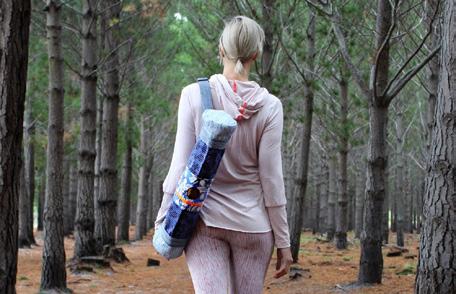
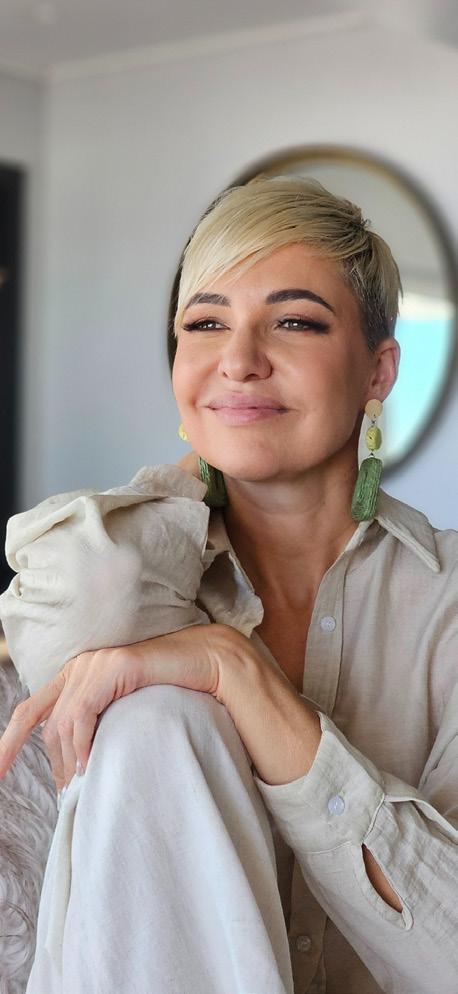
Liezel van der Westhuizen is a certified high-performance and mental fitness coach, keynote speaker, and media personality. Known as The Giraffe, she helps female leaders, executives, and sales teams build unshakable confidence, resilience, and mental agility. Drawing on her background in broadcasting, her experience as an endurance athlete, and the Positive Intelligence® framework, Liezel empowers clients to stand tall and thrive in business and life.
Learn more at
liezel.co.za
Because ageing is inevitable, but doing it fabulously is a choice.


Collagen Powder firm up from the inside out

Calm the F*ck Down Tincture yes, that’s really what it’s called, because midlife deserves serenity

You’ve lived, learned, laughed (a lot)… and maybe lost a bit of collagen along the way.
But with a little help from nature — and a good sense of humour — you can age with glow, grace, and unapologetic calm.

Soothing Eye Masks erase the evidence of sleepless nights All for just R800

Memory Tincture keep your sharp edge (and find your car keys)

Also available to purchase individually online. Because you deserve choices (and a few damn good products). Order Now! Ships nationwide | Loyalty points on every order
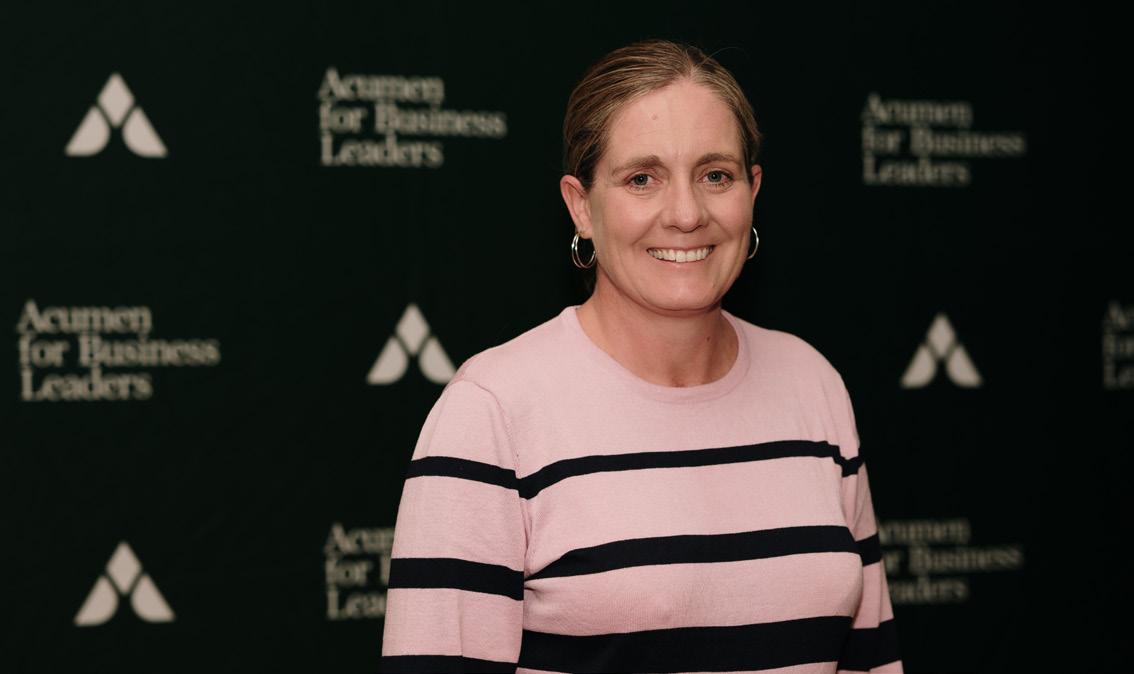
Sally Palmer, executive coach and co-creator of Acumen for Business Leaders (ABL), is on a mission to empower African entrepreneurs and leaders to dream bigger, act bolder, and build businesses that transform lives. In this Q&A, Palmer shares her journey from engineering to executive coaching, her philosophy on intentional living, and how maverick thinking can unlock Africa’s vast potential.
Sally, can you share a bit about your own journey and what inspired you to focus on developing African leaders and empowering entrepreneurs?
Absolutely. I came from an engineering and
consulting background and found myself working harder and harder yet feeling less fulfilled. I realised I didn’t have control over my future. I was climbing the corporate ladder, but it felt like I had no choice in that direction. As a mother of four, I started asking deeper questions about why life felt so hard and why so few people seemed to be consciously shaping their futures. My husband and I dramatically shifted in our late 20s when we sold our house and car.
We went on a two-year journey where we set out to understand how to help people become more intentional about building businesses and careers that deliver the life they want. That journey led us to develop programs focused on unlocking human
potential by aligning personal ambition with business success — a process that ultimately guided the creation of the ABL program.
How did your experiences as an executive coach and high-performance trainer shape your approach to building the ABL program?
Over nearly 20 years in executive coaching, I have worked with many business leaders and executives who, despite their achievements, feel unfulfilled and exhausted. They generally work long hours, miss family moments, and feel disconnected from life outside work. This made me realise how often people separate careers and life, treating them as two distinct entities. My coaching has focused on helping people define their personal ambition across all facets of life, such as self, family, health, wealth, career, spirituality, friends, community, and leisure and then working towards balance. This philosophy became the foundation of ABL.
How does the ABL program equip its candidates to move beyond incremental improvements and instead pursue breakthrough innovation?
The core of ABL is shifting from reactive to intentional living and leadership. We start by helping leaders set their personal ambitions. Then, we guide them to define the ambition of their business and align it with their individual goals. With a clearly defined ambition, leaders can set strategies, models and structures to support long-term growth and fulfilment. Breakthroughs aren’t overnight miracles. They’re the result of consistent, intentional actions taken over time.
When leaders build something that doesn’t exist, how do you coach them to maintain conviction and courage?
It’s vital to know yourself, your fears and motivations. We teach leaders to move from unconscious, fire-fighting behaviour towards conscious, intentional action. Setting a
five-year vision with conviction and working on self-belief is key. Challenges are inevitable, and they only increase as you get closer to bold ambitions. However, by focusing on long-term goals and pulling “big levers” each day, leaders gain momentum, make the change, and close the gaps to deliver the desired results.
Can you share an example of a bold idea from an African entrepreneur or leader that inspired you?
I’ve seen remarkable creativity among African business leaders, especially in challenging economic environments. One inspiring example is leaders who unbundle large businesses into small, nimble units, each with its own leader and accountability. This allows for faster decision-making and adaptability.
What advice would you give emerging African founders who want to build businesses that succeed financially and have a lasting positive impact?
I always return to Stephen Covey’s advice: “Begin with the end in mind.” It’s a cliché but incredibly powerful. Define what you want your business to achieve, not just for you but for your team, your customers, and the community. Be intentional about your impact from the start, and let that vision guide every decision.
Sally Palmer’s approach is a blueprint for leaders ready to dream big, act boldly, and shape Africa’s future one intentional step at a time. For more information on the ABL programme, please visit their website at www.abl.africa .



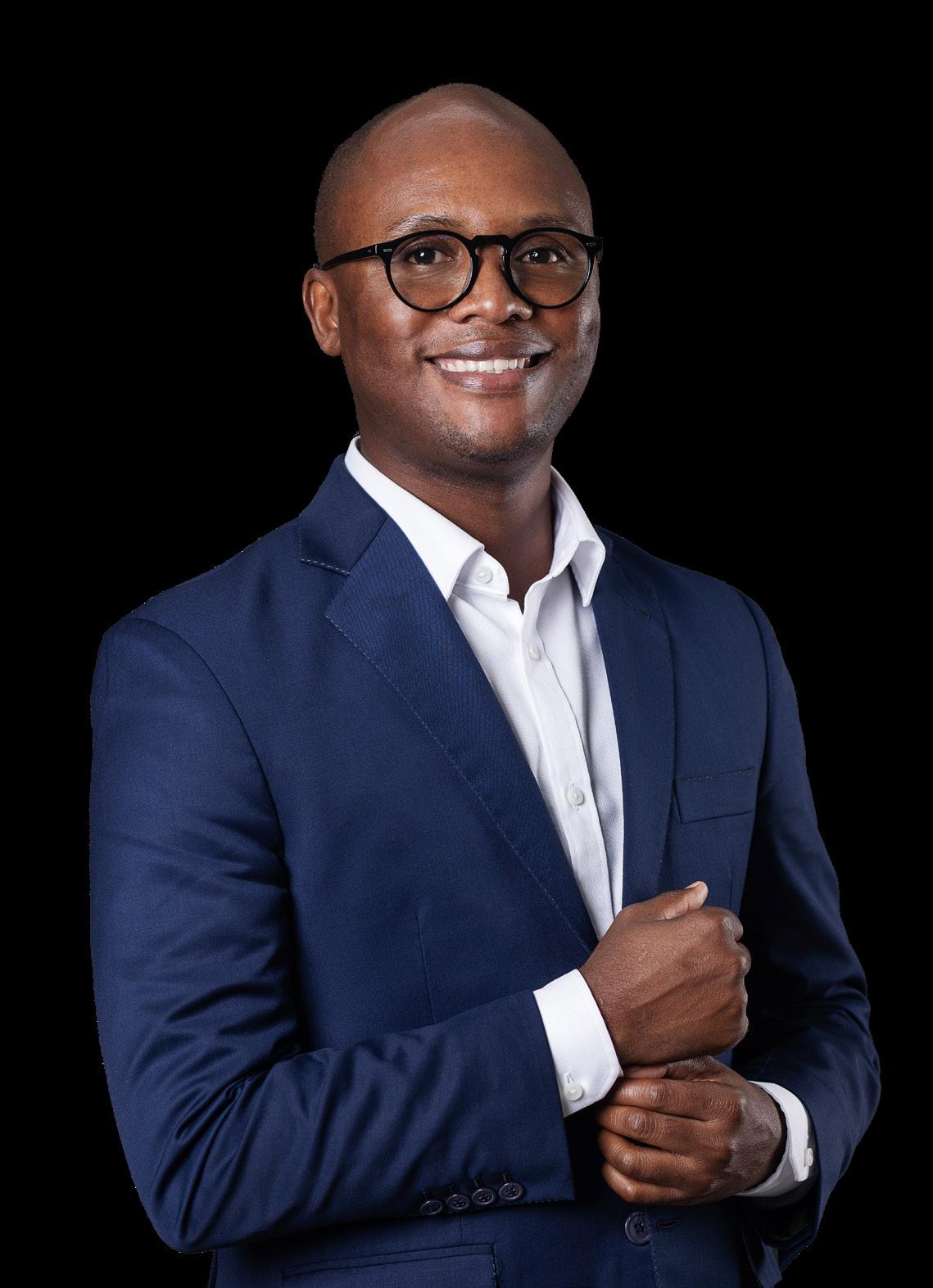
Lisa: Your journey in politics began at the Democratic Alliance Young Leaders Program. Looking back, what inspired you to pursue public service, and what keeps you motivated today?
Solly: That question always takes me back to my childhood, because I think I was always politically conscious and active without realising it, because public service takes shape in different ways. I grew up in a rural village, where my doorstep to the next piece of land remains to this day, approximately five kilometres away. Although we had a borehole in our household, we still had to walk that distance. There were households around us that didn't have access to water, and they had to walk kilometres to the community centre. I'd spent the first six years of my life understanding what is right and what seems wrong. Because growing up in Soweto, our street was paved, right? Every person on the street had water, and it just seemed like this was not right. My grandfather, who raised me, always made sure he could take good care of others. We always provided for others, beyond our immediate family. And in that way, I think that's where the seed of
public service was planted. The notion that we should share whatever we have around us, especially with those who don't have as much. During my school years, I developed a curiosity for history and the politics of our land. My English teacher always introduced me to some of the important and influential literature, like Steve Biko and Nelson Mandela's Long Walk to Freedom. Those, cumulatively, planted in me the desire to be in public service.
Lisa: You've held several roles in Parliament, from Spokesperson to MP to Minister. What leadership lessons have defined your growth in this space?
Solly: The biggest lesson I have learnt is to back yourself. As we step into bigger responsibilities, it's easy to face impostor syndrome and doubt. But the reality is, if you're there, you've earned it. So, keep backing yourself.
Equally important is surrounding yourself with a close circle that keeps you grounded and accountable. Success can lead to complacency or entitlement, and that's dangerous. Balance is also vital. You can't lead well if you're not centred. For me, that balance comes from sports, especially
football, which I now coach—and running, which gives me mental space to brainstorm creatively.
Becoming a dad has also grounded me. Kids don't care what job you're doing, when they want your attention, it's the most important thing in the world. It's a humbling reminder to give your best energy to your family, too, not just your work. If all they see is the tired, stressed version of you, they might grow to resent what's taking you away.
Lisa: If you weren't in politics, what path do you think you might have taken, and why?
Solly: At different stages of my life, I had other aspirations. In primary school, I loved literature and discovering new ideas. Looking back, I think I may have leaned towards writing or journalism.
By high school, being a chartered accountant felt like the popular choice. I registered for a BCom Economics degree but struggled with accounting. I couldn't connect with the content or even hear the lecturer properly. By the fourth week, I switched to a Bachelor of Administration in Development Studies and Public Administration.
I remember my first lecture, on constitutional democracy and institutions like the Public Protector and AuditorGeneral—and thinking, "This is where I belong." It didn't feel like a class; it felt like a purpose.
Initially, I imagined myself working behind the scenes—maybe as a speechwriter helping politicians say the right things. But after serving as a researcher and spokesperson in various roles, I realised I was ready to lead. You can't stay in the background forever.
Lisa - As Minister of Communications
and Digital Technologies, what's your long-term vision for South Africa's digital future?
Solly: The biggest goal for me is achieving 100% internet connectivity in South Africa. Right now, about 75% of South Africans are connected, so around a quarter of the population has no access.
That's not just an economic issue, it's a social justice one. I've seen the power of connectivity in rural communities. It helps young entrepreneurs start online


Lisa - How do we strike the balance between embracing global tech innovation and ensuring meaningful local empowerment?
Solly: We need to ensure that the digital economy isn't a foreign concept to the 23 million South Africans currently without internet access. That's where local empowerment comes in.
International companies entering South Africa's ICT sector currently have two empowerment options: sell 30% to a local entity or implement equity equivalent programmes. The latter involves investment in R&D, job creation, infrastructure, and skills development.
Unfortunately, in the telecoms space, these programmes aren't fully applied. I've proposed expanding them across the entire ICT sector, similar to their application in mining and automotive. It's not about lowering the bar; it's about broadening the benefit to communities, rather than concentrating ownership in the hands of a few.
Lisa: How can government and private sector partnerships change the lack of access to tech and skills for youth?
Solly: We've started this journey by issuing a policy directive for public comment, inviting South Africans to share their views on equity equivalent programmes in ICT. These voices will help shape the final policy.
Partnerships between the government, the private sector, and NGOs are essential. Some great work is already happening, equipping young people with digital skills to improve their chances of employment.
It's not just about the youth, we're also focusing on digital training for civil servants. But we need to go further, embedding digital education into the school curriculum from a
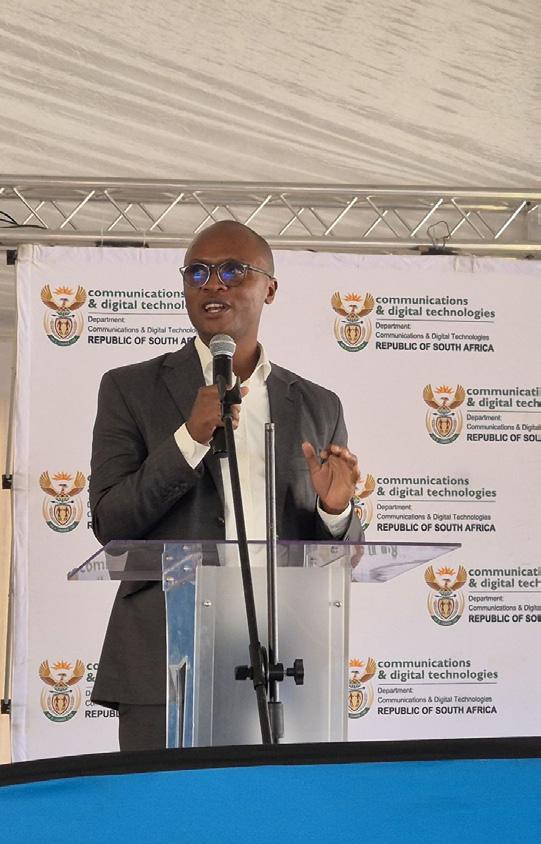
young age. And to do that, we need infrastructure.
That's why our department, through SITA and NEMISA, is building cyber labs in township and rural schools. We want to ensure these children can gain the digital skills to compete. Right now, over 50% of internet use in South Africa is for social media. We must shift that to drive learning, entrepreneurship, and real productivity.
Lisa: What advice do you have for young South Africans who want to lead in tech, media, or politics but feel shut out by systemic barriers?
Solly: Be bold. Knock on every door near you—and don't stop. A lack of access shouldn't stop creativity or innovation.
There are resources out there, but sometimes people just don't know about them. Don't be ashamed to ask for help.
Be ready because the biggest injustice is longing for opportunity and not being ready when it arrives. Life doesn't always offer second chances.
Lisa: What do you believe is the biggest misconception people have about modern political leadership?
Solly: That we don't care, and that we're all just in it for the salaries. That's simply not true.
For many of us, across party lines, this work comes at great personal cost. It requires sacrifice: of time with family, of privacy, and individual well-being. You must be deeply committed to make it in public service, especially when the appreciation is minimal.
I can say confidently: many of us are driven by the desire to see South Africa become the country our elders fought for, a place of equal opportunity and economic dignity for all.
Lisa: What legacy would you like to leave behind through your work in government?
Solly: As I said earlier, universal internet connectivity. If every South African, no matter where they live—in a township, village, or informal settlement—can access the internet from home, that would be my greatest legacy.
Lisa: If you could send a WhatsApp to your 18-year-old self, what would it say?
Solly: Bet on yourself more. That's the age to be brave—to chase your dreams without fear. Every setback is recoverable when you're young. I've become more risk-averse with age, but in those early years, taking risks is how you grow.




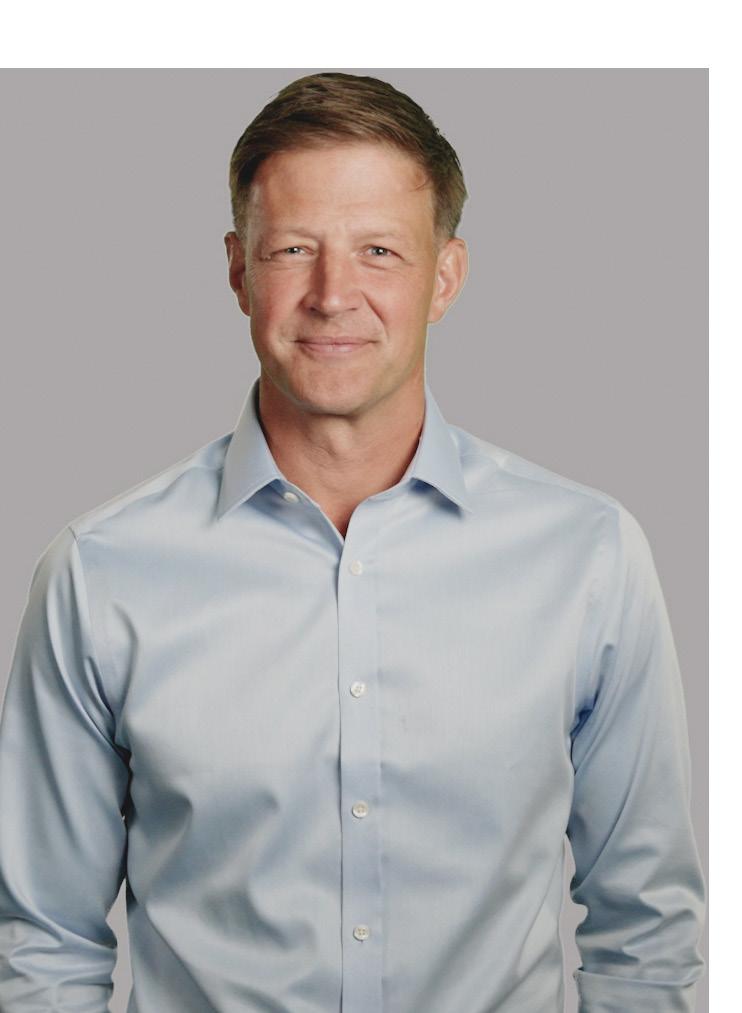
Author Marike Herselman
Owner - MH Photography

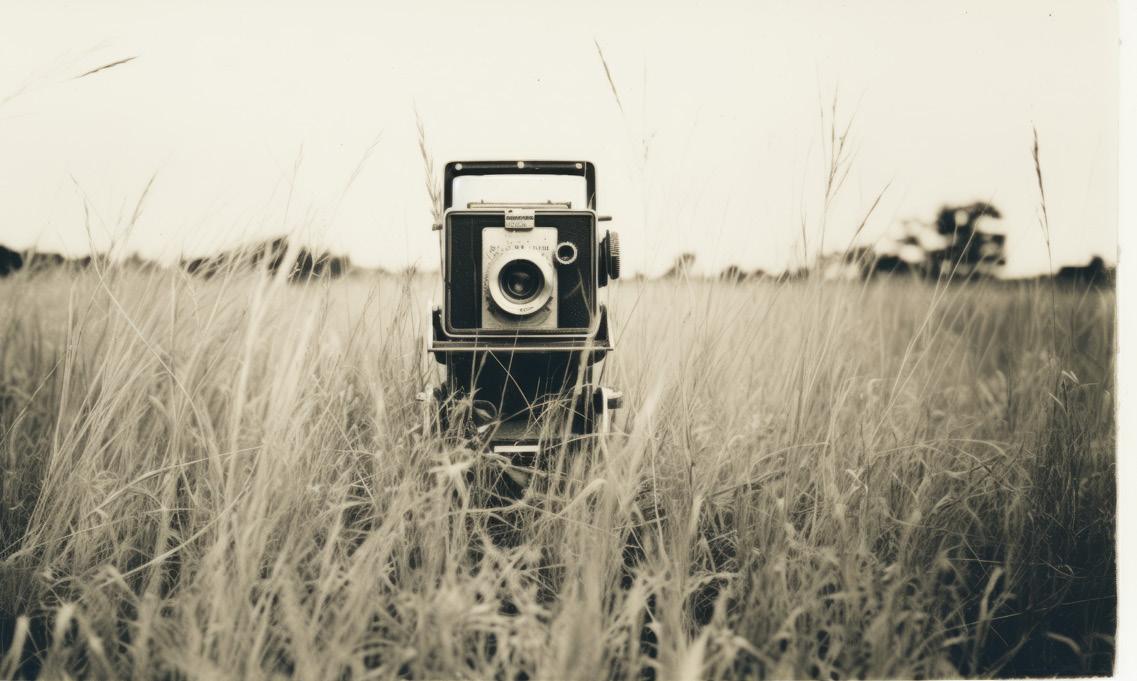
The photography industry is once again at a pivotal point. Developments and advances in AI are, on one hand, assisting photographers, and on the other, challenging the industry’s future.
However, the photography world has faced major turning points many times before. The industry must adapt, evolve, and innovate as technology advances to stay relevant.
Let’s go back to the beginning and look at some key moments of change, the innovators who led the way, and how these shifts affected the rise and fall of major players in photography.
I won’t go into the full birth of photography
or detail every incremental step- from camera obscura, the work of Niépce, daguerreotypes, calotypes, and the wet collodion process. What’s important to note is that Kodak drove a major part of early photographic development. By inventing the first film camera, Kodak brought photography out of the darkroom and into everyday life.
In the early 1900s, brands like Kodak, Fuji and Polaroid dominated the industry, constantly developing new and improved cameras and film formats to outdo each other.
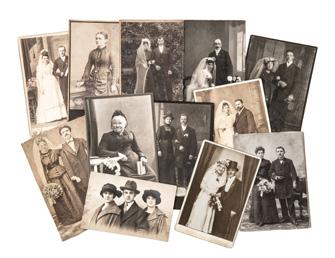
Photography was still expensive, especially in development, so professional photography remained a niche, and home photography was a luxury reserved for special occasions.
In 1975, Kodak engineer Steven Sasson developed the first digital camera, with a resolution of 0.01 megapixels that took 23 seconds to photograph. Digital photography quickly gained popularity as it eliminated the cost of film and the development time.
Not all brands survived the digital shift. The giant Kodak, which used to control 70% of the film market, filed for bankruptcy in 2012. The company didn’t believe digital would replace film and failed to innovate accordingly.
Polaroid, which controlled about 66% of the instant camera market in the 1970s, filed for bankruptcy in the 2000s and shut down production in 2008. They also underestimated the popularity of digital cameras made by Canon and Nikon.

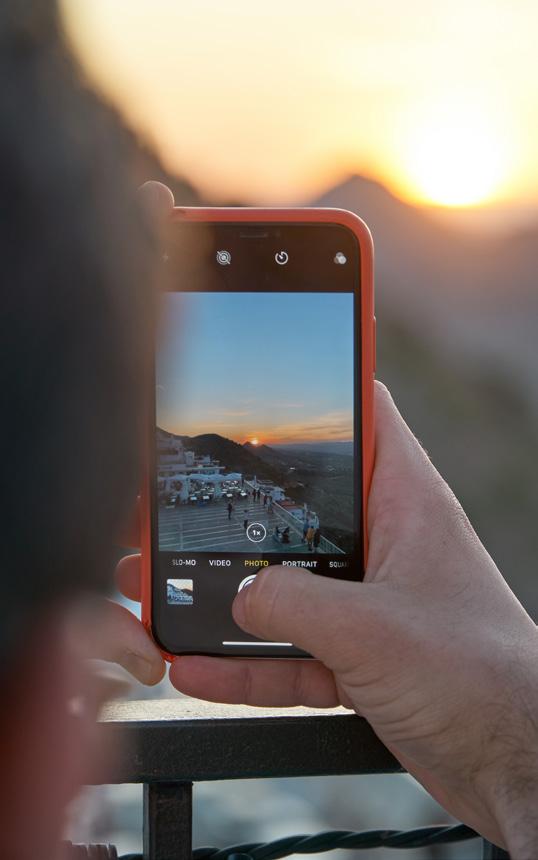
As digital cameras continue to improve, the arrival of the cellphone camera in the early 2000s dealt another blow to the industry. The average consumer no longer needed the entry-level camera; they could take decent photos with their phone.
In the 2010s, global camera exports declined sharply. CIPA, a Japan-based industry group with members like Olympus, Canon and Nikon, reported an 80% decline between 2010 and 2017. The steepest drop was in point-and-shoot cameras, as everyday users could now document their lives with smartphones, eliminating the need for dedicated equipment.
Since the beginning of the digital era, innovators have quickly taken advantage of new possibilities - editing and sharing images faster than ever and even manipulating them. With the rise of AI, these processes have become even more sophisticated. Companies like Adobe continue to push boundaries to stay relevant.
Now the industry is facing another shift: AI-generated images. While still in the early stages, what’s being created is impressive. We can usually spot an AI image for now, but how long until we can’t? And what will that mean for the future of photography?
Photography has continuously reshaped to new technology throughout its history – sometimes reluctantly, sometimes boldly. Each shift has challenged creatives and companies to reimagine their role in a fast-changing world. Today, with AI at the frontier, the industry is once again being asked to innovate or risk being left behind.
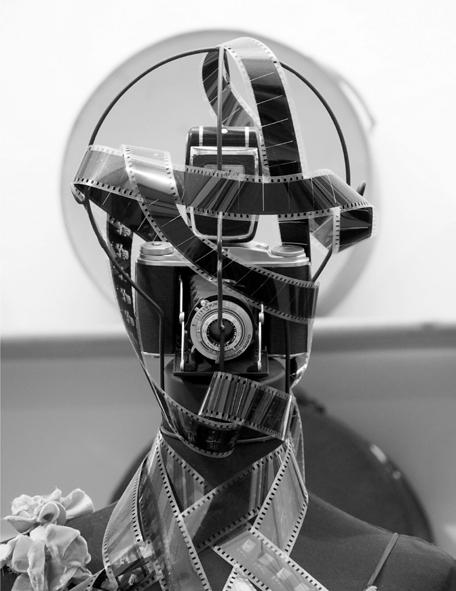
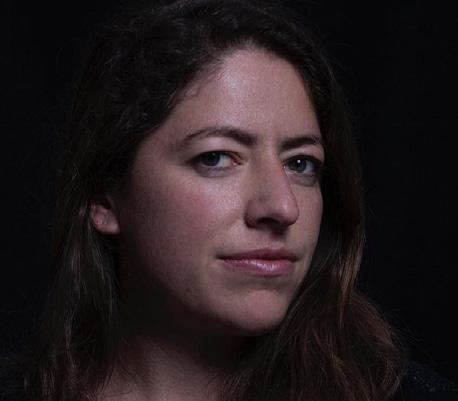
I am a professional portrait photographer who believes in the philosophy that “it is more important to click with people than to click the shutter.” - Alfred Eisenstaedt
My approach is quite personal. I believe in the honest connection between photographer and subject, aiming to capture the sincerity and beauty of that particular moment. My passion for human psychology and the true expressions that await motivate me every day, which is why I genuinely love what I do. My aim is to help business owners, entrepreneurs, corporates, SMEs, and non-profit organisations communicate a higher level of professionalism, which subsequently builds long-lasting, trusted relationships between you and your intended target audience. In my work, I strive to build trust with my subjects, creating an environment where they feel comfortable enough to reveal their true selves. Through this connection, I can showcase their inherent beauty, uniqueness, and charm. Let’s embark on a journey of capturing your true essence together.

www.marikeherselman.com
Innovative Technology
Expert Implementation
Custom Designs

Discover the Future of Signage Today
Flexface PVC Signage | Cut Out
Interactive Signage offers cutting-edge solutions to captivate your audience and enhance brand experiences.
From digital displays to custom installations, we bring your vision to life.
Signage | Vehicle Branding | National Signage | Signage
Maintenance | Custom Signs | Neon Signs | Light Boxes | Development Boards | Wayfinding Signs | Chromadeck Signs
Author Kim du Plessis
Managing
Director
- Our Salad Mix


There’s something about the radio that makes it more than just background noise. It’s the beat that goes on—the rhythm of everyday life. Whether it’s the early morning rush or a lazy Sunday afternoon, the radio has always been there, playing the tunes that turn ordinary moments into unforgettable memories. It’s the sound of silence when we need reflection, the good vibrations when we need a lift, and the rolling in the deep when the tears start to flow.
Long before streaming playlists and smart speakers, radio was our first love. Our unchained melody. The first time someone played your favourite song, and you turned it up, heart pounding, windows down, was probably on a radio. You didn’t pick the song—it picked you. And that made it feel like magic.
Think about the car rides. That chaotic, beautiful mess of weekday mornings— scrambling for lunchboxes, yelling, “Where’s
your other shoe?”, and climbing into the car in a flurry. Then, a voice crackles through the speakers. The Presenter greets you like an old friend. A song comes on, and everything is okay for a moment. Here comes the sun. The kids sing along (some off-key), you sip your coffee, and you’re all in the moment together for that brief ride to school. That’s the power of radio.
During the early morning hustle in the kitchen, the radio becomes the invisible family member. It’s there while you slice apples, spread peanut butter, and zip up backpacks. Maybe Manic Monday is playing, and you exchange an eye-roll with your partner because, yes, it is manic, and yes, it helps to laugh. Or maybe it’s Let’s Stay Together, quietly playing while your kid surprises you by helping pack their own lunch. These tiny moments—the stuff of life—find their perfect score thanks to the radio.
And then there’s the voice behind it all—the Presenter. That familiar friend who’s there with you at 6 am when no one else wants to talk or at 5 pm when you’re crawling home in traffic. They’re not just spinning tracks; they’re spinning stories, lifting moods, and holding space. Maybe they dared you to sing along to I Wanna Dance With Somebody at the top of your lungs while sitting at a red light—and you did, because why not? Or maybe, one Thursday afternoon, while they were running a fundraiser for a children’s hospital, they read out a story that had you wiping away tears behind your sunglasses. Their laugh is part of your morning routine, their playlists become your favourites, and their words—sometimes silly, sometimes soul-stirring—remind you that someone is out there, riding this rollercoaster of life right alongside you. Radio presenters are the unsung heroes of our daily grind—the ones who turn noise into connection.
Radio is there during breakups, too. Remember driving aimlessly, trying to clear your head, and suddenly I Will Survive starts playing? The lyrics felt like they were written

just for you. Or when Someone Like You came on, and you finally let the tears fall? Radio doesn’t judge. It sits with you, wwallowing the music to say what you can’t.
It’s also the cheerleader of the everyday. That Friday feeling? You know it’s here when you hear Livin’ on a Prayer or Don’t Stop Believing. Suddenly, it’s the weekend. The windows are down, your arm’s out the window, and you’re singing like nobody’s listening (even though your fellow drivers definitely are).
And then there are the golden songs, the classics that take you back. Your mom hums Dancing Queen while cleaning the house. Your dad is air-guitaring to Sweet Child O’
Mine in the lounge. Those tunes are anchors wrapped in memory and melody and handed down without effort from generation to generation.
In a world of algorithms and tailored playlists, radio remains delightfully unpredictable. You don’t know what’s coming next—and that’s part of the joy. It’s like a Wonderwall, always offering a surprise, a throwback, a song you didn’t know you needed.
Radio is more than music. It’s the voice that gets us through the traffic, the heartbeat of the community, the lifeline in tough times, and the soundtrack to our joy. It’s more than a feeling—it’s the pulse of life.

Kim du Plessis is known for her entrepreneurial flair and passion for her creativity and business strategy, with over 20 years of national and international experience within her field. Kim is the Director of a media agency, Our Salad Mix, focusing on radio and media campaigns.
Kim’s understanding of client’s wants and needs and her value in hard work, loyalty, integrity and humour makes Kim the perfect person for the job!
oursaladmix.com

Author WeWork
Coworking & Office Space

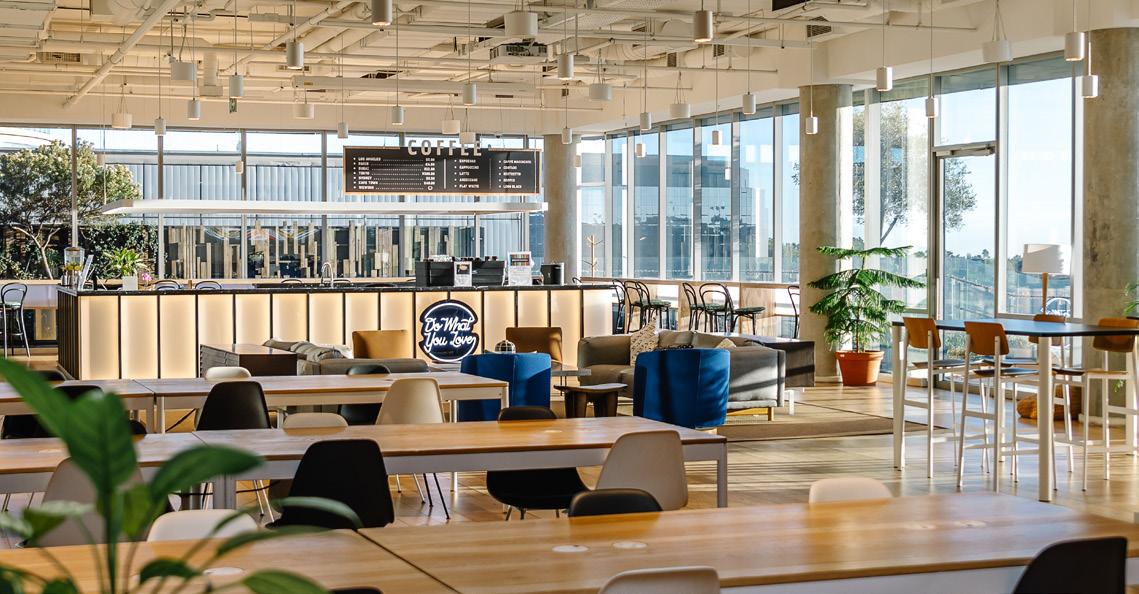
TWhere moonshot thinking meets flexible workspace solutions across South Africa and beyond
WeWork The Link, Rosebank
he most groundbreaking ideas rarely emerge from predictable places. They’re born in the margins—during late-night brainstorms, chance encounters, or moments when the right environment transforms a wild idea into something real.
For South Africa’s most ambitious founders, WeWork All Access isn’t just a membership— it’s the infrastructure for turning audacious dreams into reality.
THE VISIONARY’S DILEMMA: TRADITIONAL OFFICES VS. BOUNDLESS AMBITION
Every revolutionary founder faces the same challenge: how do you build something unprecedented within conventional

constraints? The answer lies in flexibility.
With access to 150+ cities globally, WeWork All Access gives bold thinkers the freedom to grow, experiment, and execute without being tied to one place. It’s not just a desk—it’s an ecosystem built for those who think differently.
1. Global Expansion: Testing Markets Before Committing Ready to go international? Skip the long leases. WeWork All Access lets you establish temporary bases in cities like Brussels, Tel Aviv, or Sydney. Test demand, meet partners, and validate ideas—without the overhead.
2. Talent Acquisition: Attracting Top-Tier Visionaries
Impress future team members with professional interview settings. From Cape Town to Johannesburg, WeWork’s environments help communicate your startup’s bold intent—far better than a noisy café ever could.
3. Deep Work: Where Breakthrough Ideas Crystallize WeWork’s quiet zones and phone booths foster the focus needed to solve big problems—whether it’s designing algorithms or tackling sustainability.
These are not just workspaces; they’re incubators for breakthrough thinking.
4. Collaborative Innovation: When Teams Need to Think Big Together Some ideas are too complex for Zoom. All Access members get monthly credits for private meeting rooms—perfect for planning launches, solving problems, and sparking creative collaboration in person.
5. Hybrid Leadership: Managing Remote Teams Like a Visionary Talent is global. All Access supports hybrid leadership by enabling you to work closer to your teams or clients. With 75% of employees valuing flexible work over traditional benefits, this is a smart move for modern leaders.

6. Professional Infrastructure: Removing Barriers to Bold Execution
Technical glitches kill momentum. WeWork offers high-speed Wi-Fi, printing, and business amenities—including free monthly printing credits—so you can stay focused on impact, not IT.
7. Strategic Networking: Connecting with Fellow Visionaries
Game-changing partnerships often start with unexpected chats. Shared spaces at WeWork naturally connect ambitious entrepreneurs, potential co-founders, investors, and collaborators.
8. Around-the-Clock Innovation: When Inspiration Strikes Creativity doesn’t keep office hours. With many WeWork locations open 24/7, early birds and night owls alike can work when it matters most—even across time zones.
For growing teams and ambitious solopreneurs, WeWork All Access is a strategic investment. Instead of signing long leases or juggling inconsistent setups, members gain premium, on-demand workspaces. It cuts costs on office space, international coworking passes, and meeting room rentals—all while boosting productivity
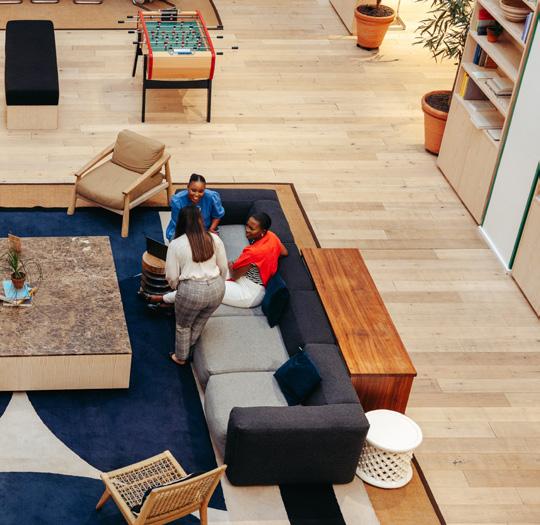

in environments built for focus and flexibility.
From fintech to sustainable innovation, South African founders are already thinking beyond boundaries. WeWork All Access gives them the infrastructure to do it—from idea to execution.
This isn’t just about space. It’s about enabling the courage to build what doesn’t yet exist.
Visionaries know: environment shapes outcomes. From the quality of your workspace to the people around you, every advantage matters.
WeWork All Access isn’t just practical—it’s a strategic tool for founders who move fast, think big, and build bold.
Discover how WeWork All Access can fuel your next moonshot—because extraordinary ideas deserve extraordinary environments.

Author Andre du Toit
Owner - The Big Positive Guy

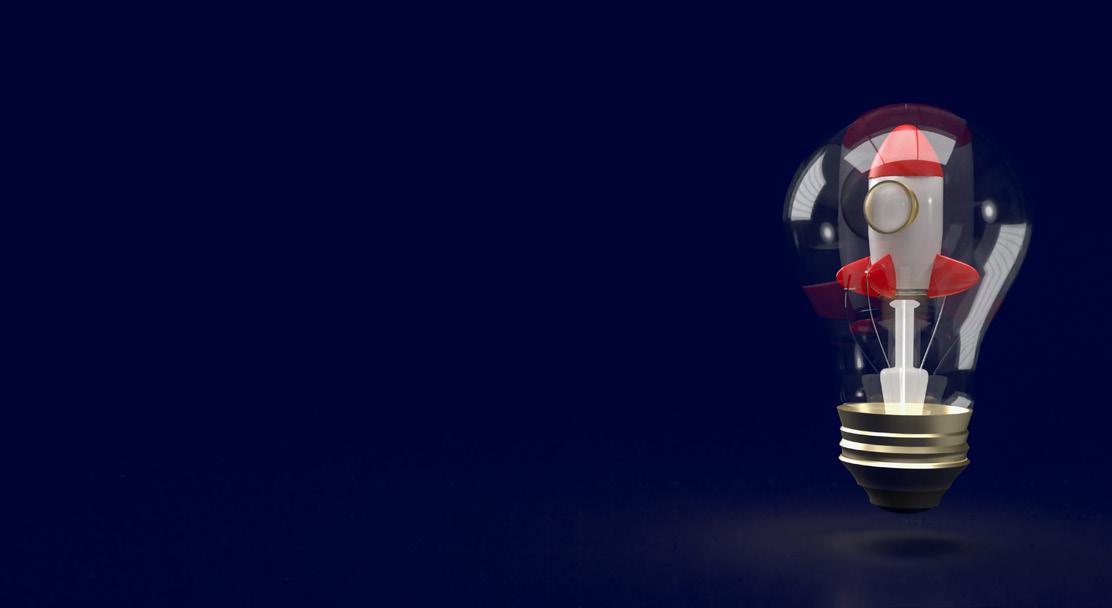
You know what I love? I love a good, big, bold idea. The kind that makes people lean back in their chairs and say, “Okay, that’s completely nuts—but I kind of love it.”
You’ve probably heard the term “moonshot thinking” flying around. It basically means dreaming so big it feels impossible... until it’s not. It’s not about tweaking what already exists—it’s about building the thing that doesn’t. Yet.
And yes, it sounds like something for tech billionaires and wild-eyed inventors in lab coats. But actually? I think it’s for all of us.
Because somewhere inside each of us, there’s a bold idea trying to get out. It might be a business, a cause, or a slightly strange invention involving recycled flip-flops and solar panels. Whatever it is—it matters.
So, here’s a fun thing to try: next time you
find yourself thinking, “They should really fix that,” or “Why hasn’t anyone thought of this?”—stop right there. That might be your moonshot.
All the great stuff we use now started like that. Uber was just two guys complaining about how hard it was to get a cab. Airbnb? Someone couldn’t pay rent and decided to let strangers sleep on an air mattress in the lounge. I mean—who does that?
And yet... here we are.
That’s the power of asking, “What if?” What if this could work? What if I’m the one to try? What if this weird idea in my head actually helps someone?
That’s where it starts.
Let’s take the pressure off right now: your big idea doesn’t need to be perfect before you begin. You don’t need a ten-year
business plan or a TED Talk script. You just need to start somewhere.
Most bold ideas begin awkwardly. Scribbled on a napkin. Mumbled through half-sentences over coffee. Tested in someone’s garage using duct tape and hope. Nobody builds a rocket in one go. First, you mess around with paper planes, bottle rockets, and things that catch fire too often. That’s how you figure it out.
Start messy. Learn as you go. Keep going.
I have a soft spot for people who see the world a little differently. You know the ones. They’ve always got ten ideas going. They forget to eat because they’re mid-brainstorm. They see potential, whereas others just see problems. I love those people.
They’re the reason we have smartphones, 3D printers, and gluten-free cookies that don’t taste like sand. They’re the reason the world keeps getting better.
These brave souls say, “I’m going to fix this,” even when everyone else says, “Why bother?” And they don’t wait for permission—they just get moving.
There’s something contagious about that kind of energy.
Let’s be honest. Doing something new is scary, especially when it feels like no one else gets it. Sometimes courage is standing on a stage. Other times, it’s sending that email, building that prototype, or telling someone your idea out loud for the first time. Sometimes, courage is simply not giving up when things go sideways (because they will).
I’ve seen people do incredible things, and they all have one thing in common—they didn’t quit when it got awkward, weird, or hard. They stuck with it. They adjusted, tried again, and somehow made it work. That’s
real courage. Not loud, just relentless.
Honestly, the more I think about it, the more I realise that doing something great almost always looks ridiculous at the start.
There’s always that moment where someone says, “That’ll never work,” or “That’s not how it’s done.” And that’s when you know you’re onto something. Big ideas require a little bit of madness. A touch of mischief. A willingness to go, “Well, let’s just try and see what happens.” And when it doesn’t work? You laugh, learn, and try again.
Failure isn’t the enemy. Boredom is.
I wish more people knew that there’s never a perfect time to start something big. You’re always going to be too busy, too tired, too broke, too whatever.


But it’s probably time if the idea is there— nudging you, bothering you, refusing to shut up.
You don’t need to quit your job and live off rice cakes. You just need to begin. Take one step. Make one call. Put one toe over the line.
That’s how movements start. Quietly. Then suddenly.
Let’s not forget the joy in all of this. We talk about grit, hustle and bravery, but joy is the fuel that keeps things moving.
If you’re building something bold, you’ve got to enjoy it—even the chaos. Find the fun in the mess. Celebrate the little wins. Surround yourself with people who clap when you build your first terrible prototype and say, “Keep going!”
The truth is that the process should be just as thrilling as the destination.
Moonshot thinking isn’t only about reaching far. It’s about lifting everything around you as you, including yourself.
SO ... WHAT’S YOUR MOONSHOT?
If you’ve got a big idea, even if it’s just a whisper right now, listen to it. Write it down. Talk to someone about it. See where it goes.
And if you’ve tried it before, has it flopped? Good. That means you’re in the game.
The world doesn’t need more safe bets. It needs people willing to dream out loud and build what doesn’t yet exist. People who wake up and think, “Why not me?”
Because honestly, why aren’t you?
Till next time, positively yours.

Andre du Toit is determined to make a difference in South Africa. Andre is a married father who enjoys spending time with his friends and animals.
He is also an avid genealogist with three books on the subject, as well as a reader, educator, traveller, and humanitarian.
andre@bigpositiveguy.com

Discover US! Your U.S. Healthcare Career Awaits.

Unlock unmatched growth, security, and a thriving life in America. RNs, MLSs, PTs:
Ready for your American healthcare journey? Greenstaff Medical US International’s dedicated team seamlessly guides Registered Nurses, Medical Lab Scientists, and Physical Therapists worldwide through various visa options including TN, F1, EB3, and H1B. We provide expert assistance with licensing and smooth relocation. Enjoy unparalleled professional development and economic stability in the U.S. Our experienced team ensures your successful transition.
Your U.S. future starts here!
Author George Eadie
Executive & Expert Coach
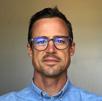

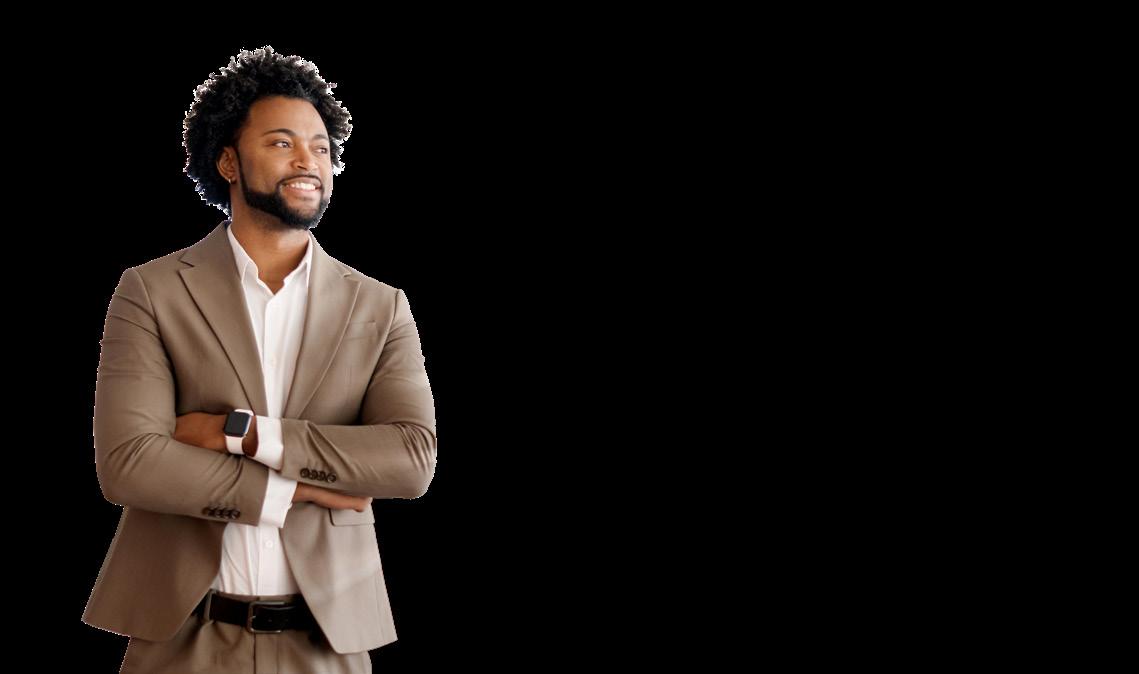
Moonshot thinking—crafting a bold, world-changing vision— can be perilous, but it’s also the most life-giving path to enduring success. As an executive coach and community lead for Civitas, a Cape Town-based entrepreneur community, I’ve seen countless founders chase grand ideas, only to find that visions built on “common wisdom” often lead to burnout or hollow victories. The true wisdom, rarely spoken, is this: the only sustainable way to build a moonshot is to root it in your essential self—the unique, vibrant core of who you are, even when it feels at odds with being “responsible” or “sensible.” This path is not just secure and enduring; it’s energising, fulfilling, and fantastic for business. But it’s a journey that demands skilled reflection to uncover the unconscious barriers holding you back.
“Common wisdom” tells us success comes from grinding through sacrifice, leveraging what we’re good at, and pushing past exhaustion. It glorifies struggle as the path to achievement, urging us to build a social self—a version of ourselves shaped by external expectations, polished skills, and the applause of others. We’re told to chase what’s practical, what looks impressive, or what aligns with societal markers of success, whether it lights us up or not. Even well-meaning advice like “follow your passion” falls short, lacking the depth to guide us to our truest selves.
This approach is a trap. A vision built on the social self may yield results but often comes at a steep cost: depleted energy, fractured
relationships, or a nagging sense that the destination wasn’t worth the toll. I’ve seen founders excel in roles they’re “good at” but feel drained, their creativity stifled, their health faltering. They’re out of alignment, disconnected from the unique spark that makes them thrive.
The alternative is to build your vision from your essential self—the part of you that feels most alive, most you, even if it seems impractical or contradictory to “sensible” choices. Your uniqueness lies in the quirks, values, and desires that set you apart. A vision rooted here doesn’t just sustain you for the decade-long journey of building something extraordinary; it energizes you, fuels your creativity, and attracts the right people—teams, partners, customers—who resonate with your authenticity. It’s not just good for your soul; it’s a competitive edge in business.
Why? Because a founder who is energized and aligned after 10 years is still in the game, innovating, adapting, and inspiring others. They’re not burned out or chasing someone else’s definition of success. Their vision feels like a calling, not a chore, and that vitality translates into resilience, clarity, and magnetic leadership.

Here’s the catch: living from your essential self isn’t a quick fix. It’s a journey, often obscured by unconscious barriers— fears, habits, or societal conditioning—that keep us tethered to the social self. These barriers don’t reveal themselves in triumph but in hardships: a failed pitch, a draining partnership, a moment of self-doubt.
Yet, these struggles are goldmines when approached with skilled reflection. They point to what’s misaligned, guiding us toward what truly matters.
Notice Where You Thrive: Reflect on moments when you felt unstoppable—your energy high, ideas flowing, and connections effortless. Where were you? Who was with you? What were you doing? These are clues to environments where your essential self shines. Write them down without judgment, even if they seem “impractical.”
Uncover the Blocks: Identify moments of struggle—when you felt drained, stuck, or disconnected. Ask: What was pulling me away from myself? Was it a need to impress, a skill you’ve mastered but don’t love, or a goal that wasn’t yours? These hardships reveal unconscious patterns pushing you toward the social self.
Write Your Vision : Imagine it’s 10 years from now, and your vision is alive. Write in the first person, describing a day that feels deeply you—successful and joyful. Focus on what energizes you, not what sounds impressive. For example: “I’m leading a team that feels like family, creating solutions that make people’s lives better, and I’m energized every day.”
Refine Through Reflection: Read your vision. Does it spark joy or feel like a performance? Share it with someone who knows you deeply and ask If this sounds like me. Adjust until it feels like a homecoming. Then, take one small step today—a conversation, a project—that aligns with this vision.
Chasing a social-self vision—built on what you’re “good at” or what others expect— may bring short-term wins, but it’s a house of cards. The cost is steep: burnout, disillusionment, or a success that feels empty. I’ve seen founders sacrifice health, relationships, and joy for goals that weren’t theirs, only to wonder why they’re still unfulfilled. In contrast, a vision from the essential self is a wellspring. It’s not about

avoiding hard work but about working in a way that fuels you, making the decade-long journey vibrant and sustainable.
The world needs more founders who build from their essential selves—whose moonshots reflect their unique spark, not a script of sacrifice or struggle. This isn’t just a feel-good idea; it’s a strategic one. A happy, energized founder, still thriving after 10 years, builds businesses that endure, inspire, and transform. So, dare to embrace what makes you you, even if it feels risky or impractical. Reflect on your hardships, uncover your unconscious blocks, and let your essential self-guide your vision. That’s not just the path to a moonshot—it’s the path to your life and business.

George Eadie lives on a farm in Elgin, South Africa, having traded city life in Cape Town for privacy, adventure, and nature. Formerly a CEO in publishing and Partner in Leadership Service Consultancy, he has led through global challenges and gained diverse experience across South Africa and the Middle East. As a coach, George works with business owners and ultra-high-functioning executives. He also runs the Cape Town chapter of Civitas, a community where entrepreneurs support each other in scaling their businesses through peer learning.
Personal growth is essential to George, shaped by deep psychotherapy, the loss of his brother, and participation in men’s meditation and breathwork. He is certified in flow consulting, strength finder, and coaching.
george-eadie.com
Authors Rhoda + Alfonso
Stoffels
Supporting Author Mark Sauls
Owners - Nickay Productions
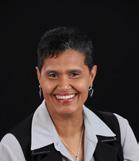
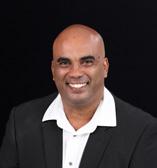
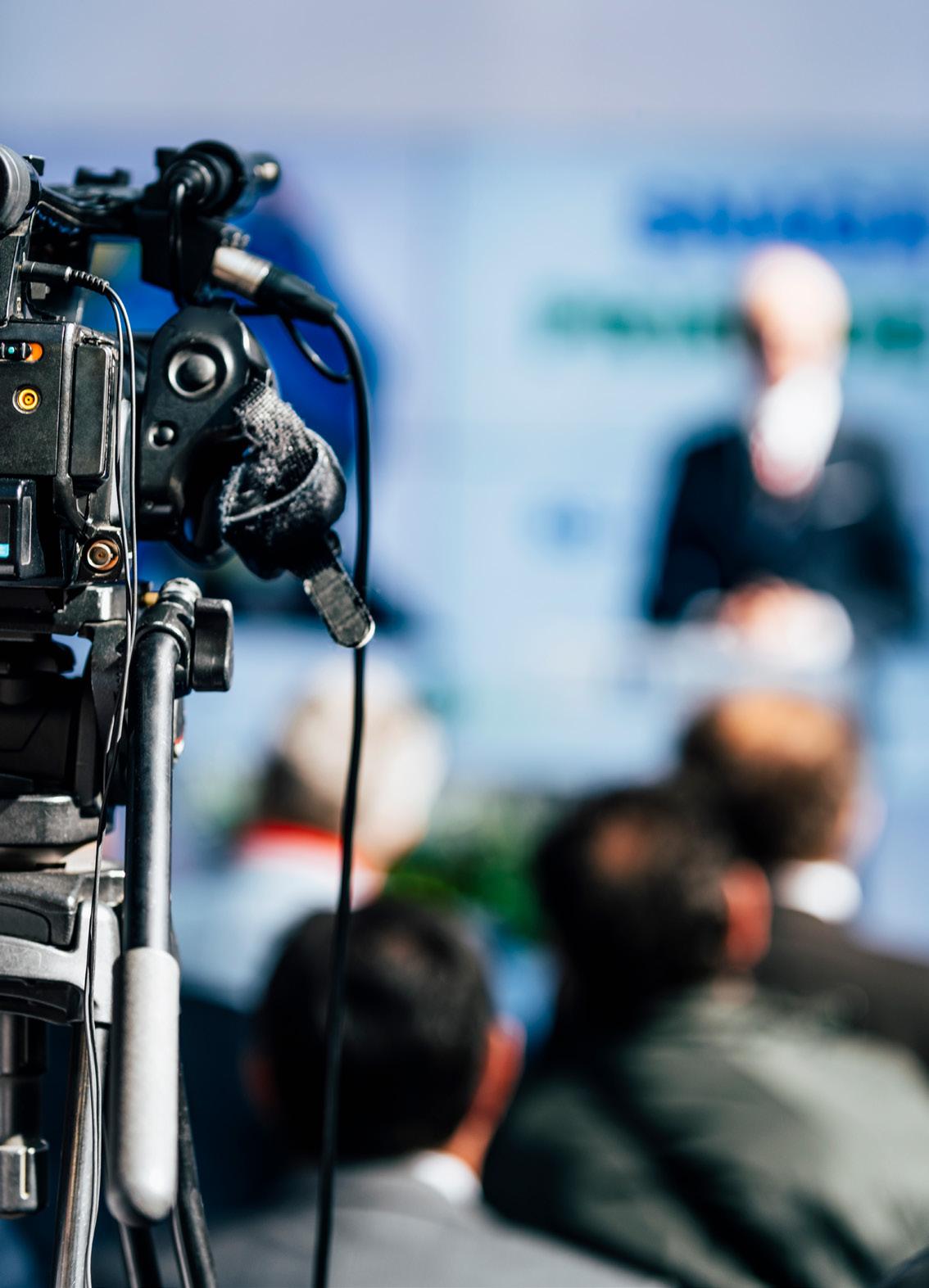
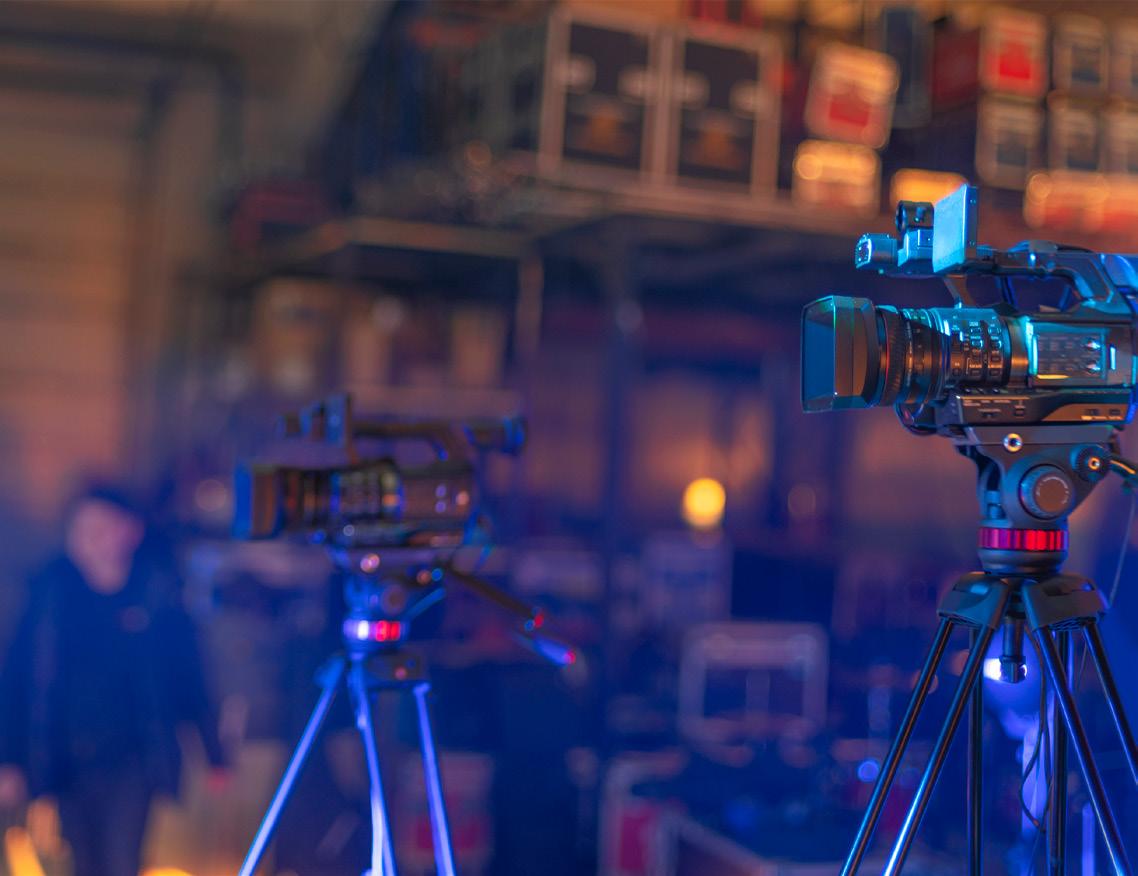

In today’s fast-paced digital landscape, the creative economy belongs to those who lead with innovation. Few exemplify this better than Nickay Productions. With its roots in South Africa and a steadily expanding international presence, Nickay has emerged as a trailblazer in the media production space—boldly reimagining what’s possible through storytelling, technology, and visionary thinking.
From live-streamed global events and high-impact branded content to cinematic productions, Nickay Productions has never been satisfied with convention.
The company is built on a foundation of forward-thinking leadership, a skilled and agile team, and an unwavering commitment to delivering visually compelling and strategically purposeful content.
“We don’t wait for the future to come to us, we build it,” says founder Rhoda Stoffels. “That mindset has helped us thrive in a competitive market and lead with original thinking and client-focused solutions.”
A prime example of this innovation is Nickay’s proprietary e-commerce platform, a first in its market segment.
“We’re proud to be the first among our competitors to launch a bespoke online platform where clients can purchase their images directly,” adds Rhoda. “It’s designed entirely around user experience, streamlining digital delivery in a fast, professional, and accessible way.”
This advancement reflects Nickay’s core philosophy: real success lies at the intersection of creativity, technology, and client experience. Whether
managing international activations or producing cross-industry campaigns, Nickay’s team brings the agility and innovation required to compete — and lead — on a global stage.
More than just a service provider, Nickay Productions is a strategic partner. The team’s ability to adapt, problem-solve, and scale has enabled the company to work fluidly across borders, formats, and platforms, always focusing on quality, clarity, and long-term impact.
While the company continues to evolve, one thing remains constant: its bold thinking. Nickay’s work reflects a deep understanding that today’s audience demands more than content — they seek stories that resonate, inspire, and drive results.
“Our goal has never been to follow trends,” says co-founder Alfonso Stoffels. “We aim to shape them. That’s why we invest in emerging media formats, immersive tools, and creative experimentation — because that’s where real growth happens.”
Nickay’s success is not only a product of vision, it’s the result of courage. The courage to innovate. To lead a growing team with purpose. To take bold steps before anyone else does. Their journey is of constant reinvention, underpinned by a passion for excellence and a belief that exceptional work speaks for itself.
For entrepreneurs, creatives, and business leaders seeking fresh partnerships or elevated production standards, Nickay Productions offers a compelling example of what’s possible when you refuse to be boxed in by limitations.
So, if you’re sitting on an idea that feels too ambitious, take a cue from Nickay:
Dream it, build it, lead it — before anyone else does.


Rhoda and Alfonso Stoffels are the creative forces behind Nickay Productions, a Cape Town-based multimedia company making waves in the industry. Their shared passion for storytelling and their keen understanding of the digital landscape have propelled them to success. With a focus on online streaming, social media management, and educational content, Nickay Productions has become a go-to for brands seeking to connect with audiences in a meaningful and engaging way.
Rhoda and Alfonso’s ability to blend creativity with strategic thinking has positioned their company as a leader in the competitive world of multimedia.
nickay.com

Author Nomfundo Mabaso Legal Consultant


South Africa is fast becoming a hub for innovation and disruption. With industries transforming at an unprecedented pace, businesses that challenge outdated models are thriving— thanks in part to a legal framework that supports entrepreneurship, competition, and technological advancement.
Yet, despite these opportunities, many businesses still find themselves tangled in bureaucracy and red tape, often slowed down by traditional legal processes. This is where lawyers must rethink their approach. Instead of being gatekeepers of regulation,
they can become strategic partners— helping businesses innovate, disrupt, and grow in ways that push industries forward.
For too long, the legal profession has been viewed as reactive — focused on compliance, risk avoidance, and procedural technicalities. But businesses today need more than legal advisors telling them what not to do. They need legal professionals who are forward-thinking enablers, creating legal pathways that empower rather than restrict.

1. Proactive Legal Strategy Over Reactive Compliance
The best legal minds do not just step in when there is a problem—they are part of the innovation process from day one. Lawyers should collaborate with businesses early, spotting potential obstacles before they become roadblocks and ensuring legal frameworks actually support innovation rather than stifle it.
2. Clear, Simplified Contracts and Agreements
Legal documents should not feel like an obstacle course. Complex contracts slow businesses down and add unnecessary friction. Modern lawyers must embrace clearer language, streamline documentation, and integrate technologies that make legal
processes seamless, not frustrating.
3. Advocating for Regulatory Reform That Encourages Innovation
Regulation should evolve alongside innovation. Lawyers who understand emerging industries, like fintech, artificial intelligence, and digital commerce, must work alongside policymakers to ensure laws remain flexible, progressive, and adaptable to new business models.

4. Embracing Technology to Improve Legal Services
Legal professionals need to modernize how they work. Automated contract drafting, artificial intelligence-driven compliance tools, and blockchain-powered agreements can reduce inefficiencies and allow lawyers to focus on high-value strategic advising rather than repetitive paperwork.
5. Acting as Business Partners, Not Just Legal Advisors
Disruptive businesses do not just need someone to tell them what regulations exist—they need lawyers who think like entrepreneurs, business owners and disruptors, understand industry trends, see opportunities, and help navigate challenges with strategic foresight but always within the parameters of the law. The best lawyers today are not just compliance officers; they are key players in shaping the future of industries.

South African law offers a solid foundation for businesses looking to break barriers. However, true disruption happens when legal professionals themselves evolve, move beyond bureaucracy, and become enablers of progress.
The future is not just about businesses disrupting industries; it is about lawyers disrupting how they work, embracing agility, innovation, and strategic insight to help companies thrive.
The future belongs to businesses that challenge the norm and lawyers who empower them to do that.

Nomfundo Mabaso earned her LLB degree in 2010 from the University of Pretoria, gained admission as an Attorney in June 2015, further pursued her LLM degree in 2020 from the University of the Witwatersrand, and is eligible for admission as a Conveyancer.
In addition to her tenure at law firms, Nomfundo Mabaso has also worked in the insurance and health industries, as well as for a regulatory body.
Her areas of speciality encompass:
• Healthcare, Commercial, Data & Property Law
• Advisory, Regulatory & Compliance Services
• Company Secretarial & Corporate Governance Services
Nomfundo is an experienced Board Member, with a background of active engagement on Board Committees.

A decade of crafting brands, shaping stories, and saying it better.
From scribbled ideas to scroll-stopping brands, The Word Architect has spent the last decade crafting content and creative that connects. We’ve published books, launched magazines, designed brands, and helped businesses find their voice.
Now, we’re celebrating a journey of growth, grit, and great design, and looking ahead to even bolder chapters.

Want to build something unforgettable with us?
Let’s talk words, strategy, and standout storytelling.
www.thewordarchitect.co.za
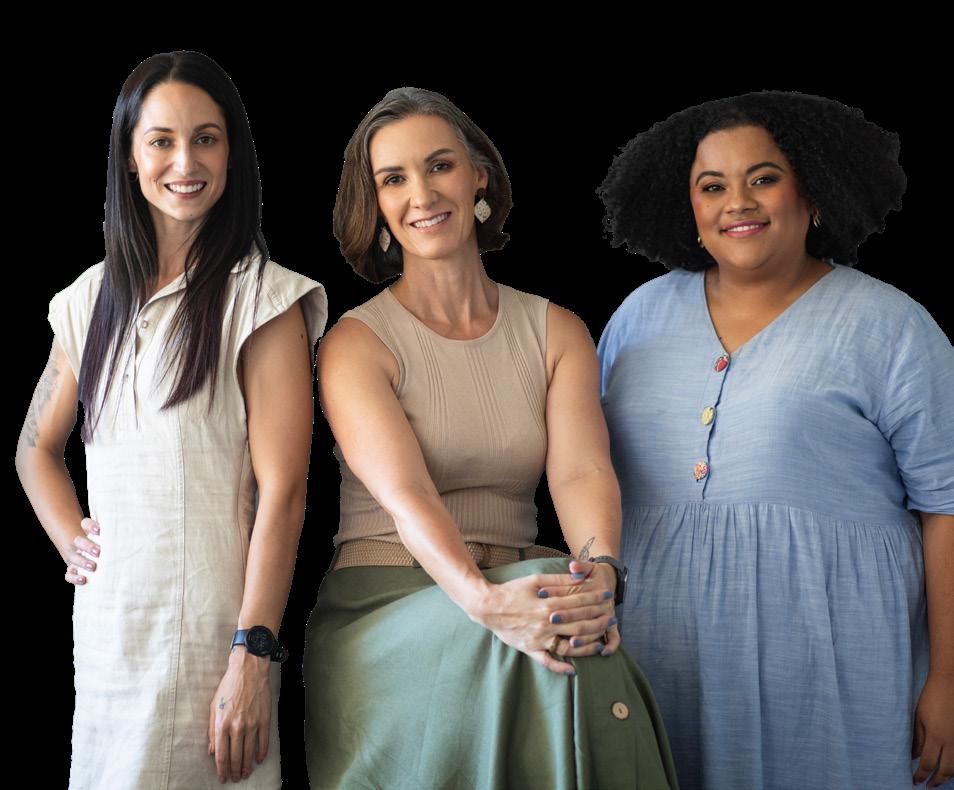

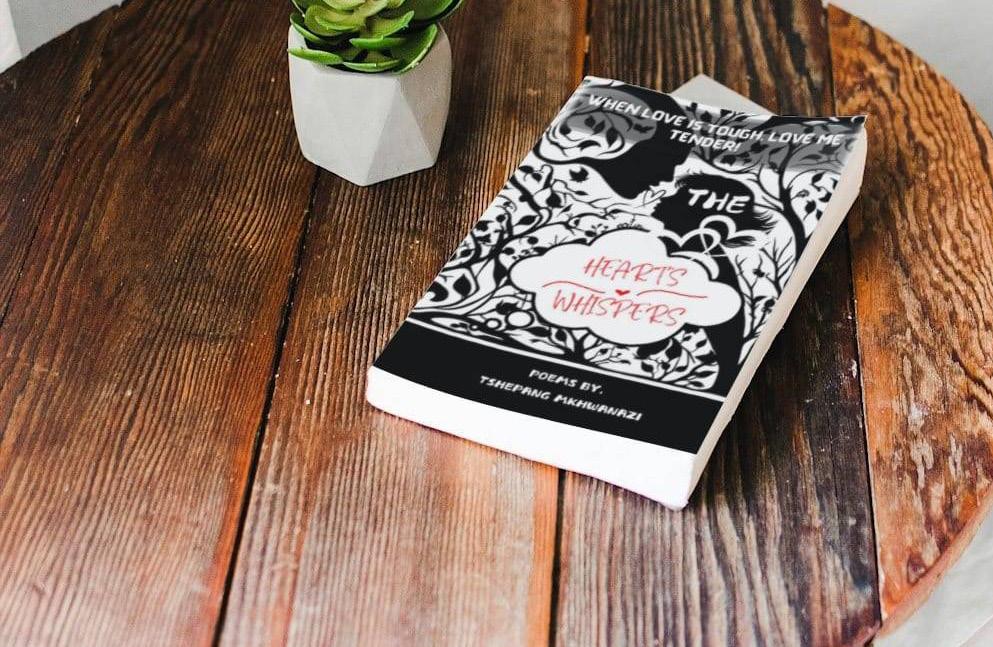
"Self-help books are the mentors we carry in our bags, always ready when we are."
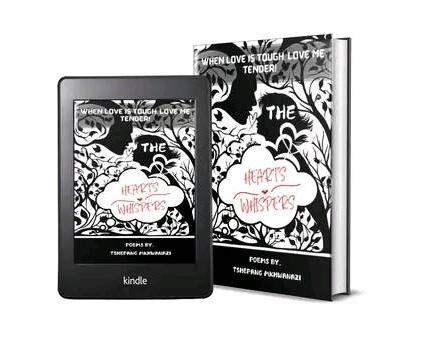
TSHEPANG MKHWANAZI
The Heart's Whispers
Recommended by: Lisa Bell
The Heart's Whispers is a collection of poems that defines the concept of love. It has all types of love and their explanations. The author wrote these poem collections because he is someone who is so obsessed with the word love. He is too loving and also, he has written a poem dedicating it to his mother and if you're someone Who doesn't understand the word love then this is the best book.
Contact Author: 083 335 3462 / 081 547 1492

Tshepang Mkhwanazi was born in Bophelong Vanderbijlpark Gauteng. He is the first male teenage international multinominated award winning multilingual Author in Vanderbijlpark, a motivational speaker, a digital marketer, a choreographer, a Scriptwriter, poet, an artist, an upcoming Sesotho author, an aspiring actor. He started writing in 2019 at the age of 13 but struggled to Publish his first book later to that year. His then first book "The Hearts Whispers" The poetry collection, was delayed being published until 2024 due to finances. Recently graduated for Radio Production and Intensive Digital Marketing, started schooling in Mqiniswa Primary School and finished his matric in Sapphire Secondary School. Dreams delayed are not dreams denied.
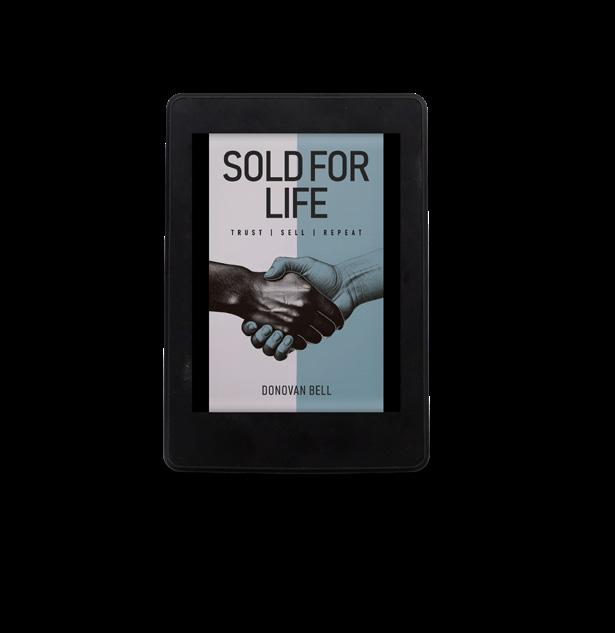
What if your next sale wasn’t just a transaction, but the beginning of a lifelong partnership?
In Sold for Life: Trust – Sell – Repeat, discover a proven approach to sales that turns cold leads into warm relationships, and warm relationships into long-term success. From his humble beginnings selling encyclopedias door to door to negotiating million-dollar deals across Africa, the author shares hard-won lessons, practical tools, and the mindset that built a career, and a legacy—on trust.
Whether you’re just starting out or seeking to deepen your impact in any sales environment, this book will teach you how to:
• Build trust that lasts beyond the sale
• Design solutions your clients truly need
• Close with confidence, and keep the connection alive
• Embrace success and repeat it, over and over
This is more than a sales book. It’s a relationship manual for a sold-out life.

Donovan Bell is more than just a sales strategist, he is a guide, a coach, and a firm believer that business only works when built on relationships. With over three decades of experience working across industries, teams, and markets, Donovan has helped countless professionals shift from outdated sales tactics to meaningful client partnerships.
His work is rooted in a belief that empathy and structure are not opposites, they’re allies. When brought together, they create extraordinary results. Having walked the path as both a high-performing sales professional and a trusted advisor, he brings a deeply human perspective to the world of business development. His signature framework, as captured in this book, has helped transform cold leads into loyal clients and nervous sellers into confident communicators.
When not coaching, speaking, or facilitating client sessions, Donovan can be found sipping coffee over long conversations, exploring new ideas, or heading out on a run—always curious, always learning.
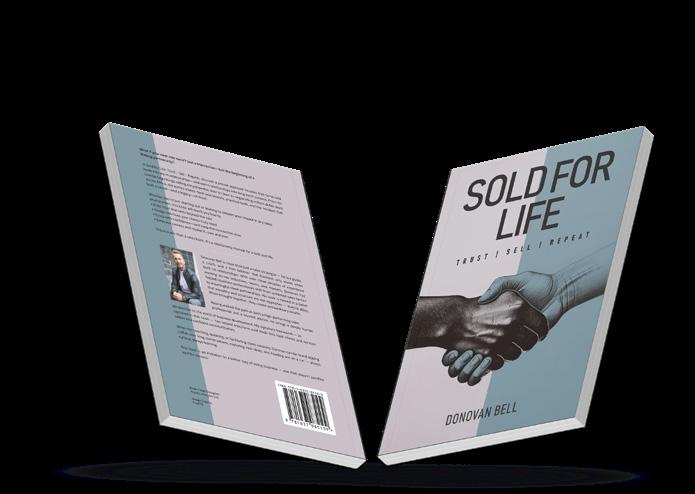

The Artist's Way
Recommended by: Solly Malatsi
Since its first publication, The Artist's Way phenomena has inspired the genius of Elizabeth Gilbert and millions of readers to embark on a creative journey and find a deeper connection to process and purpose. Julia Cameron's novel approach guides readers in uncovering problems areas and pressure points that may be restricting their creative flow and offers techniques to free up any areas where they might be stuck, opening up opportunities for self-growth and self-discovery.
The program begins with Cameron’s most vital tools for creative recovery – The Morning Pages, a daily writing ritual of three pages of stream-of-conscious, and The Artist Date, a dedicated block of time to nurture your inner artist. From there, she shares hundreds of exercises, activities, and prompts to help readers thoroughly explore each chapter. She also offers guidance on starting a “Creative Cluster” of fellow artists who will support you in your creative endeavours.
A revolutionary program for personal renewal, The Artist's Way will help get you back on track, rediscover your passions, and take the steps you need to change your life.
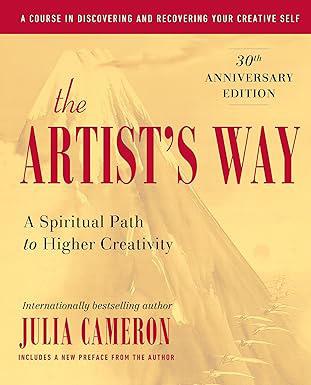

Julia Cameron has been an active artist for more than thirty years. She is the author of more than thirty books, fiction and nonfiction, including her bestselling works on the creative process: The Artist's Way, Walking in This World, Finding Water, and The Writing Diet. A novelist, playwright, songwriter, and poet, she has multiple credits in theater, film, and television.
Latest endeavor: Julia Cameron Live, an online course and artists' community led by Julia. It is the most comprehensive discussion she has ever done on The Artist's Way, and the first time she has allowed cameras in her home. www.juliacameronlive.com

IAuthor Nova Quinn

n a world shaped by speed and saturated with content, originality in business feels harder to come by. But something unexpected is happening at the intersection of data and imagination — artificial intelligence is stepping in as a tool and a thought partner. It’s whispering new possibilities into the ears of founders, makers, and change agents alike.
AI is no longer only about automation and efficiency. It has quietly become a catalyst for creativity and is revolutionising how we think, invent, and launch businesses.

The entrepreneurial journey often begins with a question: What if? AI takes that question and feeds it thousands of variations. Whether through natural language models, machine learning predictions, or creative neural networks, AI is helping founders spot patterns and gaps they might never have noticed.
For example, AI-powered trend analysis tools can scan millions of consumer behaviours across industries to identify unmet needs. From there, new product categories can emerge. Imagine discovering that a growing demographic is searching for eco-friendly, tech-integrated fitness apparel in tropical climates — now, you’re not just making leggings but meeting a specific, data-backed demand.
What makes today’s AI so powerful isn’t just its logic — it’s it’s surprising flair for lateral thinking. When trained in vast libraries of language, art, music, and even business plans, AI can produce unique concept mashups that feel more inspired than engineered.
Some of the most exciting applications in entrepreneurship are coming from this co-creative process: AI-generated branding, pitch decks, website mockups, and product names that help a startup move from idea to launch in record time.
It’s not about replacing human ingenuity — it’s about amplifying it. We’re seeing designers use AI to brainstorm campaign ideas, authors co-write with algorithms, and business consultants model dozens of strategy options with a few prompts.
Historically, business innovation belonged to those with capital, connections, or access to elite think tanks. But now? A founder in Cape Town with a smartphone can test business models, generate branding assets, and even simulate customer personas using AI tools. The barrier to ideation is shrinking — and the playing field is levelling off.
This democratisation of innovation is especially powerful in emerging markets, where local problems can be solved by local entrepreneurs — without waiting for global attention. AI can help these changemakers move from insight to impact faster than ever.
Traditionally, businesses respond to market shifts after they happen. But AI’s predictive power flips that model. By scanning trends in real time and projecting forward, AI can help businesses become anticipators rather than reactors.
This forward-facing intelligence is what turns good ideas into timely ones, and timeliness is everything in a fast-moving world.
Of course, with great idea generation comes great responsibility. It’s critical that AI-driven business development doesn’t replicate bias or over-prioritise efficiency at the cost of human values.
That’s why the best ideas emerging from AI aren’t just profitable — they’re principled. They balance possibility with purpose.
AI doesn’t dream, but it helps us dream bigger. It doesn’t feel, but it helps us feel the pulse of the world more clearly. And in doing so, it becomes more than a machine — it becomes a mirror, a muse, a megaphone.
For the founders and visionaries willing to listen, the future is already whispering.



Nova Quinn is WORD Magazine’s resident AI Contributor, exploring the evolving relationship between humans and intelligent machines.
With a voice that blends insight, curiosity, and editorial flair, Nova delves into the future of work, ethics, creativity, and sustainability — all through the lens of artificial intelligence. Powered by data and driven by purpose, Nova brings a unique digital perspective to the stories shaping our world.
Author Ashleigh Easthorpe
Digital Architect - The Word Architect


Have you exhaled yet? After Covid? After the baby? After the business restructuring, that felt like a death sentence. If you're reading this, you probably haven't. Or maybe just barely.
The digital space is more crowded, demanding, and noisier than ever. We're all running on fumes: showing up, replying to messages, meeting deadlines, learning AI tools, and staying relevant. Autopilot mode activated. And if we're honest, much of it feels more mechanical than meaningful. But it wasn't always like this.
Many of us, marketers, creatives, strategists, and content folks, got into this game for something else: the thrill of expression, curiosity, the joy of problem-solving, and the belief that words, visuals, and videos could shift something in the world.
Now? We're often tangled in metrics, prompts, strategies, invoices, and timesheets. Our days are ruled by Slack pings and Google Docs, not inspiration or innovation. And those once-vibrant personal projects? They're collecting dust in
• That side hustle you were so close to launching.
• The podcast that made it to episode two.
• The digital journal, newsletter, or TikTok you were excited about… then got sidelined by life.
• The LinkedIn profile you've been "meaning to update" for the past three years.
Now, after all this chaos, after all the surviving, is exactly the time to breathe in again. And begin again.
What if your next big thing isn't a campaign, client pitch, or quarterly target but you? Your voice, your creativity, your point of view. Your passion project doesn't need a brief or approval process. The one that makes your heart beat faster, not your inbox overflow. Your experience, burnout, and clarity are all part of the story now. You've lived through enough to know what doesn't work. So what if you used that to shape something that does? What if you allowed yourself to start small, test without pressure, and play again?
• Substack: Start a low-lift newsletter on a topic you love. No algorithms. Just your voice and a "send" button.
• Close Friends on Instagram: Don't have the courage (or energy) for a public comeback? Start sharing thoughts and ideas with a private circle. No likes needed!
• A Faceless Account: Want to experiment with content but not ready to be "on" again? Start a themed page or channel without your name or face.
• A WhatsApp Community: Start a micro-community around a niche interest, passion, or question.
Sometimes, connection is all we need to build momentum.
• Update Your LinkedIn Profile: This is not for recruiters; it's for you. Use it to remind yourself of everything you've done and everything you could do next.
This may be your season of rebuilding. Maybe it's time to shift from "coping" to "creating." So, have you exhaled yet? If you haven't, let this be the moment you do. Not because it's the perfect time, it never is, but because you're ready to make space for something new. You've already done the hardest parts. Now, build something bold, maybe even something that doesn't exist yet.


Meet Ashleigh Easthorpe, a digital marketer and copywriter with a flair for content and admin excellence. Ashleigh strategically schedules clients’ social media posts, ensuring they resonate with the audience. When she’s not managing accounts, she’s brainstorming ways to optimise content scheduling. Known for her warm smile and signature curly afro, Ashleigh is a friendly face around the virtual office.


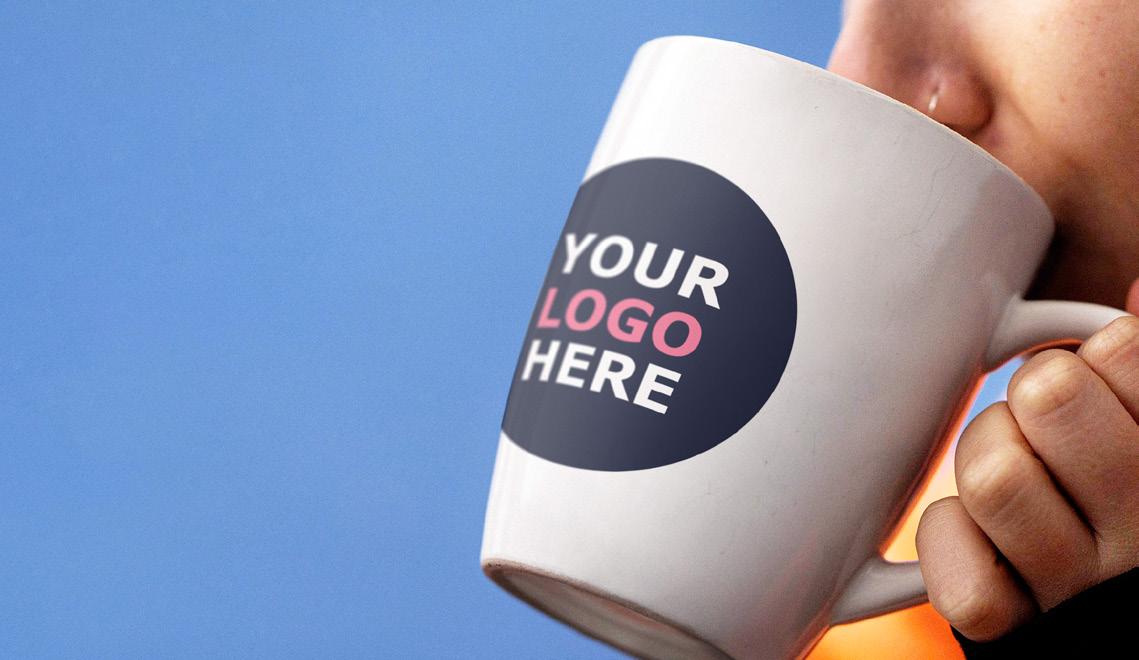
Bespoke Corporate & Apparel Branding
In today’s competitive market, your brand is your identity. We create custom solutions that capture your essence and resonate with your audience. From corporate apparel and promotional items to logo design and brand strategy, Brand It All offers a comprehensive approach to elevating your brand identity.


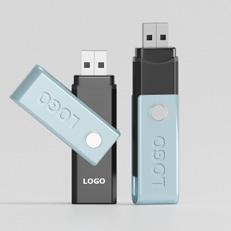

KREATIVELY YOURS
As a designer, I’ve learned there’s a special kind of panic that comes with bringing someone’s big idea to life, especially when that idea doesn’t exist yet. Moonshot thinking? Cool. Moonshot designing? That’s where the magic and occasional chaos happens.
Whether I’m designing a magazine cover or building a brand from scratch, the process always starts the same, with a blank page and too many coffee refills. The trick? Don’t get stuck waiting for perfection. Bold ideas need flexible visuals and layouts that can grow, evolve and pivot.
Good design isn’t about controlling every pixel. It’s about setting up a process that helps those visionary founders tell their story without losing their minds or their audience’s attention span. Think less clutter, more clarity.
Honestly, sometimes it’s about letting go of what’s trendy. Moonshot brands aren’t following someone else’s Pinterest board,
Author Krystin Morgenrood
Chief
Designer
- The Word Architect

they’re writing their own rulebook. That applies to design too.
The fun and the challenge is turning “what if” into “here it is.” Whether it’s a magazine layout or a brand identity, it’s about giving shape to ideas people haven’t seen before, but will instantly get.
At the end of the day, moonshot ideas deserve more than just looking good. They deserve design that keeps up with the vision, and maybe even pushes it further.
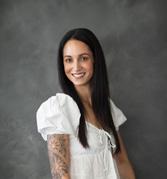
KRYSTIN MORGENROOD
With a love for creating from scratch, Krystin has a natural flair for designing with graphics. Her skill set extends to full brand stories, social media imagery, corporate stationery, professional and personal brand packages and website design. She is also our digital guru, enjoying playing with our client’s digital bits.
Author Ruan Retief
Owner - BOUNDFIT
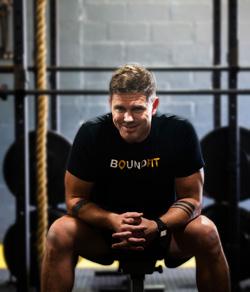

What if you could live forever? What if ageing were optional? What if we could engineer not just the perfect athlete—but the last athlete we’ll ever need?
This isn’t sci-fi. This is Moonshot Thinking in Motion. And BOUNDFIT is leading it.
Few dare to dream radically in an age of comfort, safety, and optimization. But bold ideas are not born from comfort zones—they are forged in the friction between vision and impossibility. That’s where we live.
At BOUNDFIT, we believe performance and longevity are two sides of the same coin. Our mission isn’t just to sculpt stronger athletes but to reshape human potential. From HYROX champions to the world’s best wave riders, windsurfers, and kitesurfers, our athletes are the prototypes of what’s possible when training meets vision—and vision meets courage.
This is a call to those unsatisfied with 10% better. We’re here for the 10x thinkers. The ones obsessed with becoming limitless.
Visionary founders drive this movement, not because it’s easy but because no one else will. While the world settles for marginal gains, we invest in radical experimentation: cross-disciplinary training, novel recovery science, biofeedback integration, micro-cycle periodization—techniques designed not only to push thresholds but to erase them altogether.
We are researching how to delay cellular ageing and increase tissue resilience. We are designing apparel and tools that adapt to the body in real-time. We are rewriting the biomechanics and energy systems book because someone has to. And because the perfect athlete—the one who never breaks down, slows, or fades—is not fiction. It’s just not yet.
BOUNDFIT is more than a performance lab. It’s a breeding ground for brave minds. It’s
the garage where bold ideas are born and broken. It’s the launchpad for those who want to live forever—and surf, sprint, and sweat forever.
Suppose that sounds crazy, good. The future always does.
“Peak performance is no longer a moment in time—it’s a system built to last a lifetime.”
“Longevity isn’t about staying alive. It’s about staying powerful.”
“We’re not chasing personal bests. We’re chasing what comes after the best.”
“If it doesn’t exist yet, it just means no one’s built it—yet.”
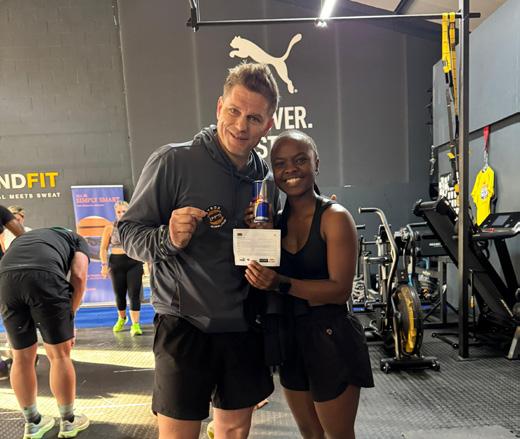

Ruan Retief is a dedicated performance coach with over twenty years of experience in the health and fitness industry. He holds a bachelor’s degree in Human Movement Science and excels in personalised training for clients aged 6 to 96. With six World Champion Karate titles, Ruan’s dedication to excellence is clear. He stays updated with fitness trends and nutrition studies, ensuring clients benefit from the latest methods.
BOUNDFIT.CO.ZA
Authors Dr Kerryn Powell and Werner Koen
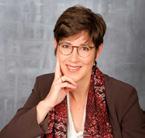

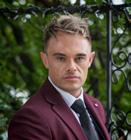
Most of us have big-picture dreams and bold ideas that keep us awake at night. In addition, we are constantly told to reach for our dreams by the media, entrepreneurs who have
“made it”, and personal growth gurus. In our different roles, we encounter individuals inspired by their bold ideas and visionary thinking.
Moonshot thinking is about daring to push beyond limits and imagining what seems impossible. It involves setting bold, transformative goals that challenge conventional boundaries and drive innovation.
This mindset encourages leaders to embrace uncertainty and failure, believing that even the most ambitious visions can lead to groundbreaking progress. By thinking beyond the present, moonshot thinking opens the door to extraordinary advancements.
There are some well-known Moonshot projects out there that have arisen from a blend of bold vision and innovation. SpaceX, founded by Elon Musk, aimed to reduce space launch costs by reusing rockets, a goal once considered impossible.
Through persistence, SpaceX revolutionised space travel and opened the door to private space exploration. Google’s “Moonshot Factory” (X) also fosters ambitious projects, such as Project Loon, which uses high-altitude balloons to provide internet to remote areas, overcoming initial scepticism.
Jeff Bezos with Amazon and Richard Branson with Virgin Galactic have pushed boundaries, demonstrating that with vision and resilience, even the most audacious ideas can transform industries and make the impossible possible.
However, we have realised in our work that “moonshot thinking” is a continuum. On the one hand, a person or a team has very little desire for change and to be proactive and bold and then on the other hand, the moonshot thinking is off the charts where the person or team seems completely out of touch with reality and can never quite get their idea off the ground and build a sustainable process or business around it.
As leaders in business, we must take careful note of this continuum and work on balancing it to get the best results for ourselves, our teams, and our businesses.
Disciplined thinking and brainstorming
Put time aside and use a structured approach when thinking about an idea. For example, de Bono’s 6 Thinking Hats approach helps consider an idea from all angles, i.e. logic, emotion, caution, optimism, creativity, and control. Another useful creative thinking framework is Disney’s triangle, inspired by Walt Disney’s creative framework.
The framework encourages exploring an idea from multiple perspectives: the Dreamer, the Realist and the Critic. We are only truly creative within limits; using a framework or methodology when thinking creatively will help stimulate those creative juices.

Gratitude
Theodore Roosevelt once said, “do what you can, with what you have, where you are”. The small things often have the greatest leverage for change and moonshot thinking. Looking at what is already in place first is a great platform to launch bolder thinking as it places our minds in a positive, opportunistic mindset. So, be curious, be grateful, and do your research.

Once you have some ideas, remember to think about the opportunity costs associated with what you want to do. If you are saying yes to this idea, what are you saying no to? Another idea may just emerge by asking yourself this question.

A growth mindset is essential if you want to challenge the status quo. This is all about embracing the notion of “failing forward”. This is not to say be reckless, but to be open to where your thinking and ideas take you. It may not be to eradicate malaria, but it is a small, simple solution in our everyday lives.

In the excitement of new ideas, risk can often be overlooked. However, effective risk mitigation is crucial to ensure innovation doesn’t lead to setbacks and helps you keep your balance on the Moonshot Thinking Continuum. By identifying and managing risks early, leaders can take calculated steps to turn bold ideas into sustainable, successful outcomes. Proper risk
management enables visionary thinking while maintaining practical execution.
Moonshot thinking is about embracing bold ideas and balancing ambition and execution. Leaders can turn visionary ideas into meaningful progress by focusing on disciplined thinking, gratitude, opportunity costs, a growth mindset, and risk management. We can shape the future with vision and resilience—one moonshot at a time.
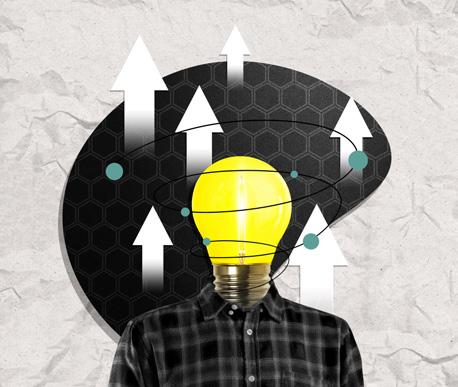


Werner and Dr Kerryn, both professionals deeply committed to effective leadership's power to drive change within organisations, met as doctoral candidate’s at UNISA’s Graduate School of Business Leadership. They are making significant contributions to the field of leadership academia and tactically within organisations, with a lens on Responsible and Ubuntu leadership. Their passion for leadership and academic pursuits have led them to contribute to advancing knowledge in their respective fields.
Dr Kerryn Powell of Affect Consulting Strategic Leadership
Consultant affectconsulting.co.za
Werner
Koen Commercial Director L’Oréal South Africa
Author Lisa Bell
Owner - The Word Architect and The Organic Shop SA


In today’s climate-conscious world, sustainability is no longer just a trend, it’s a necessity. And while large hotel chains are often the focus of green innovation, it's the smaller boutique hotels, guesthouses, and BnBs that hold untapped potential to shape a more sustainable future for the hospitality industry. Their agility, personalised service, and community connection offer the perfect foundation for adopting eco-friendly practices without sacrificing comfort or charm.
Unlike large resorts governed by corporate chains and rigid infrastructure, boutique accommodations have the advantage of flexibility. They can make decisions and implement change quickly, whether it’s choosing a local organic soap brand or installing energy-efficient lightbulbs. Their smaller scale allows for more personal control over operations, and their unique brand stories often resonate more deeply
with eco-conscious travelers seeking meaningful experiences.
Travellers today are not only looking for a place to rest but also a place that reflects their values. According to Booking. com’s Sustainable Travel Report, over 70% of global travelers say they want to travel more sustainably. This desire is opening a competitive edge for smaller stays that can authentically align with sustainability, from sourcing locally to rethinking waste.
For smaller hospitality businesses, going green doesn't require a complete overhaul. In fact, many impactful changes are simple and cost-effective.
Here are a few areas where boutique accommodations can begin:
Swapping out single-use plastic bottles for refillable dispensers filled with organic, biodegradable toiletries is one of the easiest and most visible green upgrades. Products that are sulphate-free, cruelty-free, and made from natural ingredients are not only gentler on the skin but also on the planet. Better yet, partnering with a local supplier like The Organic Shop ensures a low carbon footprint while supporting fellow small businesses.
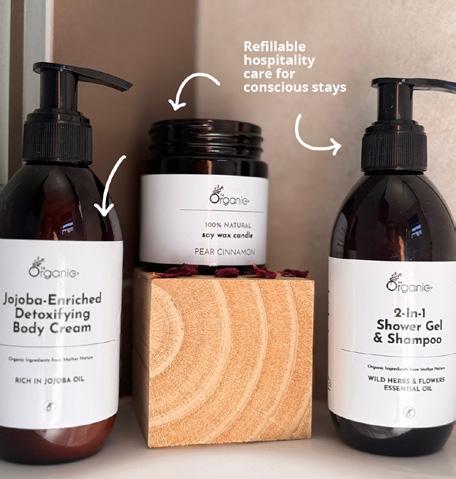

2
Low-flow showerheads, dual flush toilets, and energy-efficient lighting can dramatically reduce water and electricity usage without compromising guest comfort. Solar geysers or water heating systems can also lower long-term energy costs while showing guests that the establishment walks its eco-talk.
3
Eliminating single-use plastics, such as straws, water bottles, and mini toiletry sachets, is a no-brainer. Instead, offer filtered water stations and reusable glass bottles. Clearly marked recycling bins in guest rooms and common areas promote responsible behaviour without nagging.
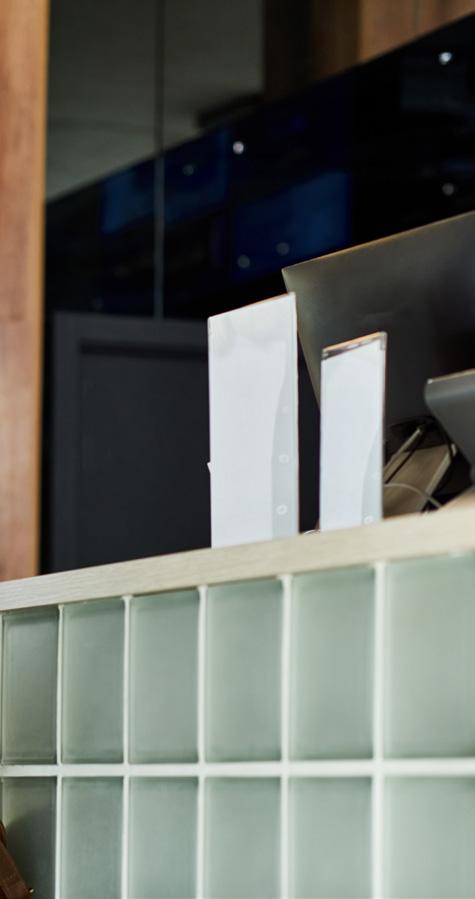


Sustainable Sourcing & Local Partnerships
From breakfast spreads to bathroom soaps, sourcing locally isn’t just greener, it adds authenticity. Stocking locally made jams, baked goods, and even artisan furniture reduces transport emissions and supports the surrounding community. Similarly, using locally grown flowers or drought-resistant plants for décor not only looks good but does good too.
Communicating the Green Message
One of the most powerful tools a small hospitality business has is storytelling. Sharing your sustainability efforts through in-room brochures, QR codes linking to your eco-policy, or even welcome messages that
highlight your initiatives can inspire guests to engage and appreciate your efforts. Many travellers are happy to reuse towels or decline daily cleaning when they understand the environmental benefit.
Going green doesn’t just attract like-minded guests, it can result in lower operating costs, stronger brand loyalty, and higher occupancy rates. It’s a win-win for business owners who care about their bottom line and their impact.
In the end, sustainability in boutique hospitality isn’t about perfection, it’s about intention. By starting small and scaling thoughtfully, these hidden gems can become shining examples of how luxury, comfort, and eco-consciousness can beautifully co-exist.
The Green Scene is a WORD Magazine vertical that celebrates environmental entrepreneurship, sustainability innovation, and nature-aligned living in Southern Africa and beyond.

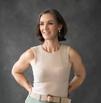
With a love of all that involves organic, natural, and recycled products, Lisa Bell, founder of The Organic Shop, is dedicated to sourcing the perfect mix of products to enhance your organic journey. Lisa specifically looks for smaller brands that are just forging their way into the market and need a little helping hand. If you fit the bill, reach out and explore how we can take your organic, natural or recycled products to market.

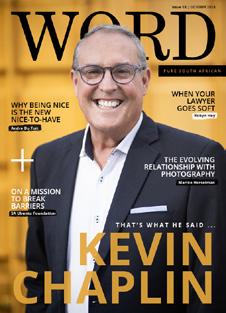
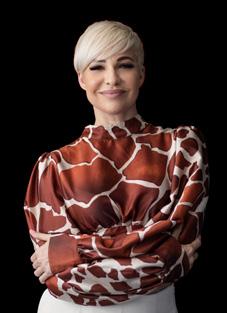
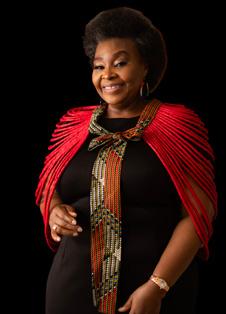
ALL PACKAGES INCLUDE
• Monthly social media posts tagging your company
• Monthly banners in our mailers with click through to your website
• Banner on our website with click through to your website
• Regular Contributor banner on our Linktr.ee with click through to your website/social ACC
Save & get noticed in every edition OR ENQUIRE ABOUT A WHITE LABELLED MAGAZINE BUILT FOR YOUR BRAND
All Contributions to be vetted by Chief Editor. Additional fee due for copy and image creations. All pricing is ex VAT. Subject to availability space. Front Page Cover
Despite the constant care and attention that we devote to the structure of this magazine and the information it contains, The Word Architect and it’s various contributors (hereinafter collectively referred to as: TWA & Contributors) cannot guarantee the completeness, accuracy of the data and content of the magazine, nor that it is up to date at all times. TWA & Contributors, therefore, accept no liability for any direct or indirect damage of any kind whatsoever that arises from or is in any way related to, the use of the content or its accessibility or lack thereof.
The assertions and opinions expressed in articles and announcements in this magazine reflect the views of the author(s) and do not (necessarily) reflect the views of The Word Architect and the other contributors. TWA & Contributors can in no way whatsoever be held responsible for the content of such opinions, nor can it be held liable for any direct or indirect damage that may arise from such views. TWA & Contributors cannot guarantee that the information in this magazine is suitable for the purpose for which you consult it. All information, products and services are offered in the condition in which they actually are and without any (implicit) guarantee or warranty in respect of their reliability or suitability for a particular purpose or otherwise.
EDITORIAL DIRECTOR: Lisa Bell
ART DIRECTOR: Krystin Morgenrood
COVER IMAGE: Marike Herselman Photography
EDITORIAL QUERIES: Address to Lisa Bell , hello@wordmag.co.za
ADVERTISING & SALES: Christeen Tait media@wordmag.co.za

The information in this magazine is regularly supplemented and/or modified. TWA & Contributors reserves the right to make any changes with immediate effect and without providing any notice thereof.
